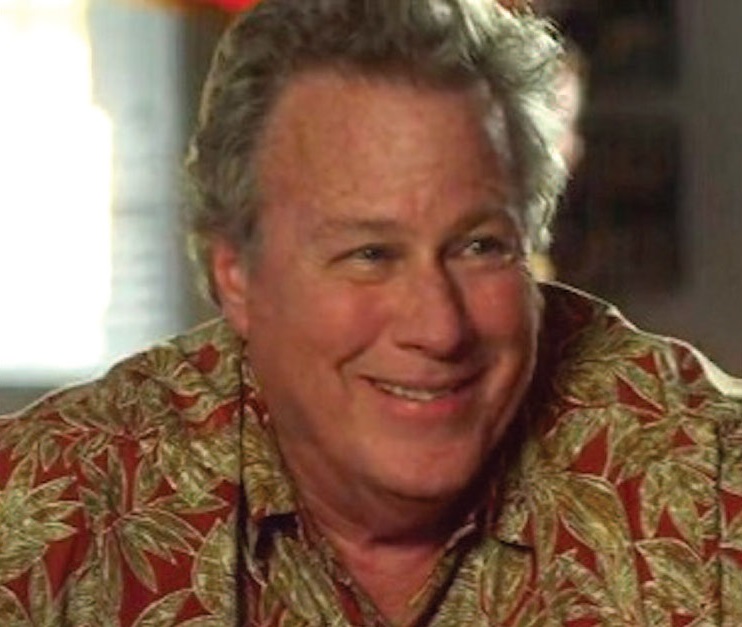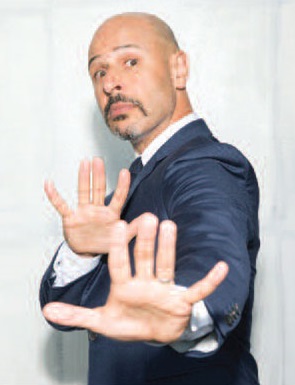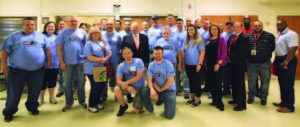 IF THESE WALLS COULD TALK…
IF THESE WALLS COULD TALK…
In recognition of Convergint Technologies 16th Annual Social Responsibility Day, 25 employees volunteered for a day of work at Trinitas Regional Medical Center’s New Point Campus in Elizabeth, NJ. The volunteers took part in revitalizing several rooms of the Behavioral Health Department with a fresh coat of paint. The brighter colors will help soothe not only patients but staff as well. Small changes such as these allow patients to feel emotionally safe and improve their overall mental health and wellness. Convergint Technologies was founded on a set of core values and beliefs, which is reflected by Convergint’s commitment to its customers, colleagues, families and, now, Trinitas.
 KIDDIE ACADEMY SPONSORS WESTFIELD 5K
KIDDIE ACADEMY SPONSORS WESTFIELD 5K
Kiddie Academy of Springfield owners Aanal & Jigar Shukla and Mihir & Nikita Desai pose with their children (l. to r.) Arya, Rhea and Rishi during Westfield’s Pizza Extravaganza and 5K run on July 26. Kiddie Academy was a proud sponsor of the annual event. The academy focuses on educating children and parents on the essentials of a healthier, more productive life—with a huge dose of fun—distinguishing it from traditional childcare options.
 THE GRADUATES
THE GRADUATES
65 students received their nursing diplomas at the Trinitas School of Nursing (TSON) Convocation Ceremony held at St. Michael’s Church in Cranford. Surrounded by family, friends, and staff that provided guidance along the way, 11 men and 54 women proudly accepted their pins and began a new chapter in their lives. It was the school’s 158th convocation ceremony.
 MESINA REALTY RIBBON CUTTING
MESINA REALTY RIBBON CUTTING
Westfield Mayor Andy Skibitsky presides over the ribbon-cutting ceremony for the new offices of Mesina Realty Group at 52 Elm Street. Mesina Rutstein, a Westfield resident and Broker/Owner of Mesina Realty Group, welcomed fellow business owners and community leaders to the event. “We couldn’t be more excited to serve such a special community,” Rustein said. “At Mesina Realty Group, we are passionate about delivering exceptional client experiences. We have experts in every field to skillfully guide you from the beginning to the end of your real estate journey.”
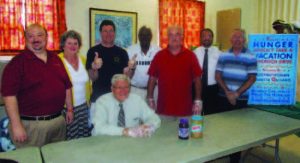 HELPING TO END HUNGER
HELPING TO END HUNGER
Over 500 sandwiches were made and distributed by members of the Elizabeth Rotary Club as part of a Sandwich Drive presented by Assemblywoman Annette Quijano in partnership with the Elizabeth Coalition to House the Homeless and St. Joseph’s Social Service Center. The event took place at the Coalition’s location on Division Street in Elizabeth.
 TRINITAS EARNS CEO CANCER GOLD STANDARD RE-ACCREDITATION
TRINITAS EARNS CEO CANCER GOLD STANDARD RE-ACCREDITATION
Trinitas Regional Medical Center has earned CEO Cancer Gold Standard™ re-accreditation for maintaining a strong commitment to the health of its employees and satisfying the latest, comprehensive requirements of the Gold Standard. To earn Gold Standard accreditation, an employer must take concrete actions to reduce the risk and burden of cancer: prohibit tobacco use and support tobacco cessation efforts; promote physical activity, healthy nutrition and weight management; provide health insurance options that include detecting cancer at its earliest stages, access to quality care and participation in cancer clinical trials; promote employee awareness of these initiatives, and support the needs of cancer survivors in the workplace. National Walking Day is just one of the many ways Trinitas continues to promote healthy living and reduce risks related to cancer.
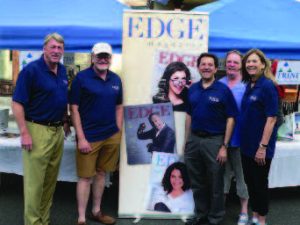 ON THE EDGE IN WESTFIELD
ON THE EDGE IN WESTFIELD
EDGE magazine staff members manned an EDGE/Trinitas display booth during the recent Westfield 5K Pizza Run sponsored by Downtown Westfield Corporation. Magazines and first aid kits were handed out by (left to right): Rob Rubilla, Senior Media Marketing Specialist; Doug Harris, Publisher; Jeff Shanes, Associate Publisher; Jama Bowman, Design Director, and Christine Layng, Media Marketing Specialist. Trinitas has been a top sponsor of the run since 2009
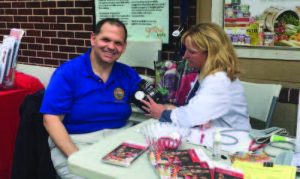 HEALTHY CORNER
HEALTHY CORNER
Trinitas Administrative Director of Diagnostic Services Ann Marie Scanlon administers a blood-pressure test during day of celebration and education for the children and families of the Elizabeth to publicize the NJ Healthy Corner Stores Initiative. The American Heart Association, Shaping Elizabeth, Bayway Family Success Center and Snap-Ed were among the event hosts. The event was chaired by Nancy DiLiegro, Ph.D., FACHE, Vice President of Clinical Operations and Physician Services/Chief Clinical Officer at Trinitas. The NJ Healthy Corner Store Initiative supports public health and economic development by linking community partners with corner storeowners to help stock, promote and sell healthy, affordable foods in underserved communities. As part of the initiative, Emily’s Supermarket added new healthy food choices to its store.
 GRAND OPENING IN SPRINGFIELD
GRAND OPENING IN SPRINGFIELD
After 68 years of doing business in Union, The Decorating Store at Terminal Mill Ends recently held a Grand Opening at its brand-new two floor decorating/design studio, now located in Springfield. Owner Ernie Spinelli (center) handled ribbon-cutting duties to mark the occasion; Township Committeewoman Geri Ann Bujnowski (to his left) joined friends, family and the store’s decorating team during the event.
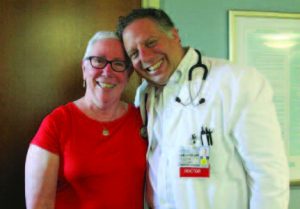 SURVIVORS DAY WARMS HEARTS AND INSPIRES
SURVIVORS DAY WARMS HEARTS AND INSPIRES
Survivors Day, internationally known as a celebration of life, was held throughout the US, Canada, and other participating countries as a show of strength that life after a cancer diagnosis can be meaningful and productive. Trinitas Comprehensive Cancer Center hosted a powerful and emotional Survivors Day where nearly 50 survivors, their family members and friends attended the event at which they viewed a short multimedia presentation on what it means to persevere despite all odds. The spirit of Survivors Day was perfectly captured by Mary Jo Daniel of Roselle Park (pictured with Dr. Barry Levinson) who gave a poignant talk about what it means to be a survivor. She concluded with some advice for other caregivers in the room: “We survivors want you to be with us for a long time. Please take care of yourself by reducing your own risk of cancer. Stop smoking, eat healthy, take a walk with us. And love. Just love.”
 THIS IS HOW THEY ROLL
THIS IS HOW THEY ROLL
Vine Ripe Markets in Westfield has been rolling out the finest fresh mozzarella every day since opening their doors in December 2015. Earlier this year, VRM launched its long-awaited educational series with their weekly fresh mozzarella class. Held every Monday evening, VRM’s mozzarella experts craft a 90-minute session to teach foodies, families and friends the fine art of making this Italian culinary staple. The class is available for purchase via Groupon for $49. With purchase, guests receive a Vine Ripe Markets Bag, including a ball fresh mozzarella, a loaf of store-baked Italian bread, and a bottle of imported extra virgin olive oil. Complimentary wine, cheese and charcuterie are also served during the class.
Submit your EDGE People event at www.edgemagonline.com
News, views and insights on maintaining a healthy edge.
 Crunch Time
Crunch Time
Do loud eaters make you crazy? Then you may be suffering from Misophonia. A small percentage of people experience a strong fight-or-flight response when they hear lip-smacking, chip-crunching or liquid-gulping sounds. A recent study published in Current Biology looked at 42 individuals—20 of whom were misophonic and 22 of whom were not—who listened to noises ranging from neutral to annoying while they were in an MRI machine. Researchers observed that the 20 misophonics had significant activity in the insular cortex, which links senses and emotions. In most cases, the result was a strong feeling of anger as opposed to disgust, which is how most people respond to eating noises. Fortunately, misophonia is fairly rare, according to Dr. Rodger Goddard, Chief Psychologist at Trinitas. “It’s a problem that usually occurs between the ages of 9 and 13 and is more common in girls, and is believed to involve brain functions and not one’s ears,” he says. There is a Misophonia Foundation, which can provide guidance for people suffering from this difficulty.

Rodger Goddard, PhD
Chief Psychologist, Trinitas Regional Medical Center Director of Wellness Management Services 908.994.7334
Dr. Goddard adds that getting upset, stressed, anxious or annoyed at a variety of things is common for many of us. We need to always look at the frequency, duration and intensity of any problem. If we have an emotional difficulty that occurs on a regular basis, lasts for a significant amount of time when it occurs, or is intense in its effect on us, then it is probably time to take action and seek professional help from a doctor or therapist.
 Into the Woods
Into the Woods
Have you planned your annual spring camping adventure yet? If not, perhaps you should. A study conducted at the University of Colorado in Boulder suggests that a weekend in the great outdoors can reset the body clock—a boon to those of us who have trouble waking up in the morning or shaking the wintertime blues. More time spent outside in bright light, and less time exposed to artificial light at night, improved alertness, mood and even strength in a group of volunteers who went on weeklong camping expeditions. The results were almost as good for campers who spent just two days in the great outdoors. This type of activity can be a great boost to one’s health, confirms

Rodger Goddard, PhD
Chief Psychologist, Trinitas Regional Medical Center Director of Wellness Management Services
908.994.7334
Dr. Rodger Goddard, Chief Psychologist for Trinitas. “Paradoxically, there is a psychiatric disorder called SAD, or Seasonal Affective Disorder,” he adds. “Some people, when sunlight is decreased or restricted, become depressed.” Indeed, light—particularly sunlight—plays an important role in our health. In addition to increased exposure to sunlight, the silence, oxygen, social connection and vacation from the technology overload can do wonders for mental health.
 Cervical Cancer’s “Racial Divide”
Cervical Cancer’s “Racial Divide”
Since reaching an all-time high in 1991, the number of cancer deaths in the U.S. has come down steadily and is now 25 percent lower than it was a quarter-century ago. That includes cervical cancer deaths, which are now largely preventable with proper screening and regular monitoring. Yet, according to a study by the Bloomberg School of Public Health at Johns Hopkins, the death rate from cervical cancer is higher than previously estimated. Much of the disparity is attributable to high rates among African-American women, who are as likely to die from the disease as someone in a developing country. Their mortality rate from cervical cancer is more than double that of white women. The study did not get into the reason for this disparity, but an article in Gynecologic Oncology suggested that the relationship between income and access is the likely cause.
 But Is It An Organ?
But Is It An Organ?
Gray’s Anatomy (the book, not the TV series) lists 78 organs in the human body. Is there a 79th? According to scientists at the University of Limerick in Ireland, the tissue that connects the intestines to the abdominal wall—known as the mesentery—should be considered an organ because it performs a specific body function. Namely, the tissue works as one entity to prevent the intestines from jigging around. Which means you couldn’t survive without it. There is an actual “advantage” to being classified as an organ. It means that medical researchers are likely to pay much more attention to it. In the case of the mesentery, that could translate into progress in the understanding and treatment of abdominal disorders such as Crohn’s disease.
 Real-Time Concussion Detector
Real-Time Concussion Detector
With football increasingly in the crosshairs of the medical community, it was only a matter of time before equipment measuring concussions in real-time started finding its way onto the field. A new “smart” mouthguard should be available to players nationwide by 2018. The device, manufactured by Prevent Biometrics, calculates a player’s risk of concussion after a hard hit. That information is sent instantly to coaches, team doctors and parents, who can pull a player out of the game if need be. This is a critical decision—study after study has shown that players who stay on the field after a concussive hit take twice as long to recover compared to those who leave immediately. The mouthguard was developed with the help of the famed Cleveland Clinic. Dr. Kevin Lukenda of Linden Family Medical Associates thinks a computerized Bluetooth mouthguard could be a valuable tool to objectively gauge whether a player is injured and to what degree he may be concussed. “Right now, we depend on referees, coaches, parents, teachers, school physicians and even the student-athletes themselves in the diagnosis of concussions,” Dr. Lukenda points out.

Kevin Lukenda, DO
Chairman, Family Medicine Department
908.925.9309
“Many times these voices go unheard because of the consequence of limiting the student athlete’s ability to play—despite jeopardizing their health. Though there are objective measures to determine a concussion, often times the decision becomes very subjective.”
 Early Detection for Autism
Early Detection for Autism
Roughly one in every 100 babies born in the U.S. ends up diagnosed on the autism spectrum between the ages of two and four. According to a study published earlier this year in Nature, brain scans can now detect the origins of autism in the first year of life. Researchers at the University of North Carolina did brain scans on a group of children at high risk of autism (their older siblings were autistic) at 6, 12 and 24 months. The scans showed early differences in the cerebral cortex—which is responsible for high-level functions— in the children who went on to be diagnosed with autism. The study should lead to new tests for autism and, hopefully, opportunities for early behavioral therapies. It also provides a compelling argument against claims that autism is caused by the MMR (measles-mumps-rubella) vaccine, which is typically given after 12 months of age.
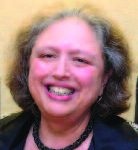
Lucile Esralew, PhD, NADD-CC, CDP
Clinical Administrator for Trinitas CARES and S-COPE
908.966.3033
“The idea that autism is caused by vaccination has been disproved,” conforms Lucille Esralew, PhD, NADD-CC, CDP, the Clinical Administrator for Trinitas’s CARES and S-COPE outreach programs. “There is no credible scientific evidence that link the two.” Until such time as brain scans are widely available, pediatricians can detect signs of autism using the Modified Checklist for Autism in Toddlers-Revised (MCHAT-R) as early as 18 months, while psychologists use the Autism Diagnostic Observation Schedule—the gold standard for assessment with children beginning as young as age three. “The Autism Diagnostic Inventory (ADI-R), a comprehensive review of a child’s early social, communication, behavioral and adaptive skills history is also utilized in assessment.” April, adds Dr. Ersalew, has been designated as Autism Awareness Month.
EDGE takes you inside the area’s most creative kitchens.
 Paragon Tap & Table • Craft Burgers
Paragon Tap & Table • Craft Burgers
77 Central Ave. • CLARK
(732) 931-1776 • paragonnj.com
Craft burgers are one of the amazing dishes featured at Paragon Tap & Table. Along with our extensive craft beer and craft cocktail lists, I have created an extensive craft burger section featuring our signature Bacon-Eater which has been featured in USA Today’s top 50 burgers in America.
— Eric B. LeVine, Chef/Partner
 Arirang Hibachi Steakhouse • Wasabi Crusted Filet Mignon
Arirang Hibachi Steakhouse • Wasabi Crusted Filet Mignon
1230 Route 22 West • MOUNTAINSIDE
(908) 518-9733 • partyonthegrill.com
We prepare a crusted 8-ounce filet mignon served with gingered spinach, shitake mushrooms, and a tempura onion ring.
 Daimatsu • Sushi Pizza
Daimatsu • Sushi Pizza
860 Mountain Ave. • MOUNTAINSIDE
(908) 233-7888 • daimatsusushibar.com
This original dish has been our signature appetizer for over 20 years. Crispy seasoned sushi rice topped with homemade spicy mayo, marinated tuna, finely chopped onion, scallion, masago caviar, and ginger. Our customers always come back wanting more.
— Chef Momo
 Publick House • Street Tacos
Publick House • Street Tacos
899 Mountain Ave. • MOUNTAINSIDE
(908) 233-2355 • publickhousenj.com
Our street tacos are part of our happy hour menu at Publick House. Made with fresh ingredients, and changing daily, they are the perfect pairing for a pint of $5 New Jersey craft beer.
— Bernie Goncalves, Owner
 The Barge • Cioppino
The Barge • Cioppino
201 Front Street • PERTH AMBOY
(732) 442-3000 • thebarge.com
Our Cioppino, the signature dish of San Francisco, features a fresh, healthy selection of clams, mussels, shrimp, Maine lobster and Jersey scallops—drizzled in Greek virgin olive oil, with fresh garlic and white wine—over homemade Italian linguini. I know it will become one of your favorite dishes.
— Alex Vosinas Chef/Owner
 Luciano’s Ristorante & Lounge • Warm Goat Cheese Salad
Luciano’s Ristorante & Lounge • Warm Goat Cheese Salad
1579 Main Street • RAHWAY
(732) 815-1200 • lucianosristorante.com
The warm goat cheese salad with tender greens and a mulled cabernet dressing and toasted pine nuts is a signature appetizer at Luciano’s, where fresh ingredients and personable service in a beautiful Tuscan décor create a fine dining experience. Our menus are seasonally influenced to feature the best of what’s available in the market.
— Joseph Mastrella, Executive Chef/Partner
 Morris Tap & Grill • Cut Rigatoni with Chicken Sausage
Morris Tap & Grill • Cut Rigatoni with Chicken Sausage
500 Route 10 West • RANDOLPH
(973) 891-1776 • morristapandgrill.com
With every season at Morris Tap & Grill the menu changes in many ways, but the classics always remain. I like to showcase local and sustainable ingredients keeping it fresh and fun. This pasta is a reflection of just that. Featured here is Cut Rigatoni with homemade chicken sausage, local broccolini, white beans and finished with garlic herb broth.
— Eric B LeVine, Chef/Partner
 McLynn’s: Social Eatery and Bar • Jersey Breakfast Bar Pie
McLynn’s: Social Eatery and Bar • Jersey Breakfast Bar Pie
250 Morris Ave. • SPRINGFIELD
(973) 258-1600 • mclynns.com
Get in the Spirit! Our Jersey Breakfast Bar Pie features potatoes, Taylor ham, cheddar cheese and onions. It doesn’t get more Jersey than that!
— Mark Houlker, Chef
 Outback Steakhouse • Bone-In Natural Cut Ribeye
Outback Steakhouse • Bone-In Natural Cut Ribeye
901 Mountain Avenue • SPRINGFIELD
(973) 467-9095 • outback.com/locations/nj/springfield
This is entire staff’s favorite, guests rave about. Bone-in and extra marbled for maximum tenderness, juicy and savory. Seasoned and wood-fired grilled over oak.
— Duff Regan, Managing Partner
 Arirang Hibachi Steakhouse • Volcano Roll
Arirang Hibachi Steakhouse • Volcano Roll
23A Nelson Avenue • STATEN ISLAND, NY
(718) 966-9600 • partyonthegrill.com
Hot-out-of-the-oven, crab, avocado and cream cheese rolled up and topped with a mild spicy scallop salad.
Galloping Hill Caterers
Galloping Hill Road and Chestnut Street • UNION
(908) 686-2683 • gallopinghillcaterers.com
Galloping Hill Caterers has been an incredible landmark for nearly sixty years. We pride ourselves in delivering “over the top” cuisine, impeccable service and outstanding attention to detail. That is the hallmark of our success! Simply, an unforgettable experience. Pictured here is one of our crepes flambé that really creates lots of excitement!
— George Thomas, Owner
 Vine Ripe Markets
Vine Ripe Markets
430 North Avenue East • WESTFIELD
(908) 233-2424 • vineripemarkets.com
For some, drinking coffee is LIFE! What about cooking with it? Next time you’re making baby lamb chops or a bone-in ribeye, try a coffee rub! Finely grind a rich coffee bean (like espresso or French roast) and blend with EVOO, coarse herbs (like rosemary), salt and pepper. You’ll get a paste-like spice rub perfect for grilling. Slather over the beef or lamb and chill for up to 6 hours before cooking. The results are a fantastic, rich flavor explosion!
A look back at the Home Alone phenomenon.
By Luke Sacher
Home Alone, the highest grossing live action comedy motion picture in history, is now 27 years old. For those of us who saw it when first released in theaters, that’s half our lives or more ago. Writer/producer John Hughes initially sold his screenplay to Warner Brothers, who flipped it to 20th Century Fox for a tidy profit. Alas, that proved to be one of the most shortsighted decisions in Hollywood history
Against a production budget of $18 million, Home Alone grossed $285.8 million in the United States and Canada, and $190.9 million in other countries, for a worldwide total of $476.7 million—a return on investment of 2,650 percent.
From its release on November 16, 1990, Home Alone was #1 at the box office for 12 straight weeks, and remained in the Top 10 until well past Easter. After nine months in U.S. theaters, it had earned 16 times its debut weekend earnings, and sold nearly 70 million tickets. Worldwide, it was the third-highest grossing picture of all time, behind only Star Wars and E.T. the Extra-Terrestrial. The movie siphoned off so much box office from competing pictures that screenwriter William Goldman coined the verb “Home-Alone’d”—now an industry expression—after receipts for his film Misery (starring Kathy Bates and James Caan) fell short of studio projections
The premise of Home Alone (the McCallister family is jetting to Europe before they realize that eight-year-old Kevin has been forgotten) stretches the limits of credulity. What made the movie was the performance of adorable Macauley Culkin and the misadventures of two bumbling burglars, played by Joe Pesci and Daniel Stern
“The last 44 pages of Home Alone were written in eight hours,” Hughes once admitted. “All that physical stuff. It was a roll as fast as I could type. I was inside that movie. Anything I did was right. When you get in there, it’s a tremendous feeling because you’re not planning it, it’s just happening. And it’s all subconscious.”
Hughes suggested to director Chris Columbus that they cast Culkin as Kevin after Hughes directed the young actor in Uncle Buck, starring John Candy. After interviewing dozens of other young actors for the part, Columbus finally met with Culkin, and agreed that he was the right choice. By law, Culkin could only work until 10 p.m. This created logistical problems for the crew because of the movie’s many night scenes. On top of that, shooting the live-action stunts was truly nerve wracking
“Every time the stunt guys did one of those stunts it wasn’t funny,” Columbus recalled. “We’d watch it, and I would just pray that the guys were alive.” Stunts were prepared and rehearsed with safety harnesses, but performed without them on camera because of their visibility. CGI technology hadn’t been invented in 1990.
Initial reviews of Home Alone were mixed. Variety remarked on the top-notch performances of its cast. Jeanne Cooper of The Washington Post praised it as pure, unpretentious entertainment. Hal Hinson, also of The Washington Post, lauded Chris Columbus’s direction and Culkin’s acting. Caryn James complained that the film’s first half was “flat and unsurprising” in her New York Times review, but applauded the second half for its old-school slapstick humor and genuine sentimentality. Roger Ebert of the Chicago Sun-Times gave Home Alone 2.5 out of a possible 4 star rating. He pointed out that Kevin’s booby traps would take a team of special-effects experts to set up and said the plot was “so implausible that it makes it hard to really care about the plight of the kid.” Owen Gleiberman of Entertainment Weekly hated the film, giving it a D and scolding it for its “sadistic festival of adult-bashing.”
Fast-forward to 2017. Home Alone is now a holiday staple, often ranked among the best Hollywood Christmas films of all time, including Miracle on 34th Street, A Christmas Story and the Frank Capra classic It’s a Wonderful Life. Hughes admits he was inspired by Capra and his portrayals of honest, everyday Americans prevailing in the world over the no-goodniks. Like Capra, Hughes and director Chris Columbus were meticulous in their casting, and it shows. All these years later, it is difficult to imagine anyone better occupying any of the key roles: Macaulay Culkin as Kevin McCallister, Joe Pesci as Harry Lime, Daniel Stern as Marv Merchants, John Heard as Peter McCallister, Catherine O’Hara as Kate McCallister, Roberts Blossom as Old Man Marley, John Candy as Polka King Gus Polinski and Hope Davis as a Paris-Orly Airport receptionist
How did they come to Home Alone? Where did life take them in the years that followed? Where are they now? I thought you’d never ask…

Hughes Entertainment/20th Century Fox
Macaulay Culkin (August 26, 1980) was born and raised in New York City, and began acting at the age of four. Named after Lord Macaulay of India, he is the paternal nephew of actress Bonnie Bedelia (Heart Like a Wheel, Die Hard). In 1989, Culkin appeared in John Hughes’s Uncle Buck and went toe-to-toe with John Candy as dead-panning Miles. After Home Alone, he was hailed as the most successful child actor since Shirley Temple—ranked #2 on both VH1’s 100 Greatest Kid-Stars and E!’s 50 Greatest Child Stars.
Around the time of shooting Home Alone, Culkin became close friends with pop icon Michael Jackson and appeared in Jackson’s “Black or White” music video. When Jackson stood trial accused of sexual abuse, Culkin testified on his behalf, and reported he had slept in Jackson’s bedroom on countless occasions. He explained that Jackson’s bedroom was arranged over two floors, and that Jackson had never sexually molested him or touched him in any improper way. Culkin referred to the allegations as “absolutely ridiculous
In 1991, Culkin hosted Saturday Night Live and starred in Home Alone 2: Lost in New York in 1992. In 1993, while a student at the School of American Ballet, he danced the title role in a filmed version of The Nutcracker, staged by Peter Martins from George Balanchine’s 1954 New York City Ballet production. Culkin retired from acting in 1994 and married actress Rachel Miner in 1998, but the marriage broke up and they were divorced in 2002. He dated actress Mila Kunis for several years and they remain friends.

Photo by Judy Clements-Turner
Culkin returned to acting in his mid-20s with generally good reviews, including a hilarious appearance on Will and Grace as an immature lawyer. He also did voice-over work. In 2010, he appeared alongside actors Matthew Broderick, Molly Ringwald, Judd Nelson, Ally Sheedy, Anthony Michael Hall, and Jon Cryer in a tribute to the late John Hughes. He also fronted a band called The Pizza Underground, a Lou Reed/Velvet Underground parody-tribute group. In 2015, Culkin starred in a dark and brilliant five-minute YouTube video as a troubled Uber driver complaining about the impact of a traumatic childhood episode when his family left him at home and he had to defend himself against a pair of criminals.
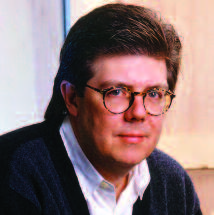 John Hughes (February 18, 1950 – August 6, 2009) was born in Lansing, Michigan. He grew up in Grosse Pointe, a toney Detroit suburb, and in Northbrook, IL, outside Chicago. His experiences in Northbrook and at Glenbrook North High School became the grist for many of his movies, as well as his literary satire
John Hughes (February 18, 1950 – August 6, 2009) was born in Lansing, Michigan. He grew up in Grosse Pointe, a toney Detroit suburb, and in Northbrook, IL, outside Chicago. His experiences in Northbrook and at Glenbrook North High School became the grist for many of his movies, as well as his literary satire
“I grew up in a neighborhood that was mostly girls and old people,” he told an interviewer. “There weren’t any boys my age, so I spent a lot of time by myself, imagining things. And every time we would get established somewhere, we would move. Life just started to get good in seventh grade, and then we moved to Chicago. I ended up in a really big high school, and I didn’t know anybody. But then The Beatles came along…changed my whole life. And then Bob Dylan’s Bringing It All Back Home came out and really changed me. Thursday I was one person, and Friday I was another. My heroes were Dylan, John Lennon and Picasso—because they each moved their particular medium forward, and when they got to the point where they were comfortable, they always moved on.”
After dropping out of the University of Arizona in 1969, Hughes began selling jokes to comedians, including Henny Youngman, Rodney Dangerfield and Joan Rivers. He worked in advertising and became the youngest Creative Director in the history of Leo Burnett Worldwide. His work often took him to New York, where he got to know the folks at National Lampoon and began writing for the magazine (secretly) on the side. His story “Vacation ’58” was the basis for the hit 1983 movie National Lampoon’s Vacation. That script, plus the one for Mr. Mom, earned Hughes a three-picture deal with Universal Studios. He went on to direct a string of popular films set around upper middle-class American high schools, including Sixteen Candles, Weird Science, The Breakfast Club, Ferris Bueller’s Day Off, Pretty In Pink and Some Kind of Wonderful. He also directed Planes, Trains and Automobiles and Uncle Buck before Home Alone. Hughes also authored screenplays for Maid in Manhattan, Drillbit Taylor and the Beethoven films.
Hughes was deeply shaken by the death of John Candy (below) in 1994 and pulled back from the movie business. He suffered a heart attack on West 55th in New York in 2009 and died at the age of 59.
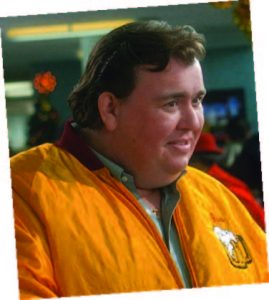
Hughes Entertainment/20th Century Fox

Hughes Entertainment/20th Century Fox
Catherine O’Hara (March 4, 1954) started her career in 1974 in her hometown of Toronto as a cast member of the legendary Second City comedy ensemble. She was an understudy for Gilda Radner until Radner joined the founding cast of Saturday Night Live. Two years later, Second City created the sketch comedy show SCTV, with O’Hara as a regular performer. In 1981, when SCTV was between network deals, she was hired to replace Ann Risley when Saturday Night Live was being revamped. However, she quit the show without ever appearing on air, and returned to SCTV when it signed with NBC. Her position at SNL was filled by longtime friend Robin Duke.
O’Hara’s work at SCTV brought her fame in Canada and the US as both an actress and writer, winning an Emmy for outstanding writing and two nominations for comedy performance. She made her feature film debut in Double Negative, which co-starred SCTV regulars John Candy, Eugene Levy and Joe Flaherty. Throughout the 1980s and 1990s, she appeared in a number of supporting roles, including Martin Scorcese’s After Hours and Nora Ephron’s Heartburn with Meryl Streep. Her most memorable cinematic roles were in Tim Burton’s Beetlejuice and, of course, Home Alone and its sequel. O’Hara also starred in four of Christopher Guest’s “mockumentaries”—three of which earned her awards and nominations: Waiting for Guffman, Best in Show, A Mighty Wind and For Your Consideration. Her role in the 2010 HBO biopic Temple Grandin earned her three major nominations, including a Primetime Emmy and Screen Actors Guild award.

Courtsey Canadian Broadcast Company
O’Hara is currently starring alongside fellow SCTV alum Eugene Levy and his son, Daniel, on the CBC comedy/satire Schitt’s Creek—a runaway favorite of Netflix viewers. She won Canadian Screen Awards for Best Lead Actress in a Comedy Series in 2016 and 2017 as the washed-up soap star Moira Rose

Hughes Entertainment/20th Century Fox
John Heard (March 7, 1945 -July 21, 2017) was born in Washington, D.C. to John Matthew Sr. and Helen Heard.
He attended Clark University in Worcester, Massachusetts, and Catholic University of America in D.C., planning initially to be a drama teacher. By the early 1970s, Heard was earning critical acclaim for his acting and by the end of the decade his stage work in New York earned him roles in movies and on television. His early films include Cutter’s Way, Cat People and C.H.U.D., in which he co-starred with future Home Alone cast member Daniel Stern. In 1988, about the time he was cast in Home Alone, Heard was in three hit films: The Milagro Beanfield War, Big and Beaches.
See our interview with John Heard on page 87.

Hughes Entertainment/20th Century Fox
Joe Pesci (February 9, 1943) was born in Newark and raised in neighboring Belleville. He was acting by the age of four and by age 10 was a regular on a TV program called Startime Kids, which also featured Connie Francis. Pesci knew Frankie Valli and Tommy DeVito growing up and, in 1959, introduced them to songwriter Bob Gaudio, leading to the formation of The Four Seasons. In the 1960s, he began his own musical career, playing guitar for several bands, including Joey Dee and the Starlighters (he was replaced by Jimi Hendrix!). In 1968, Pesci released an album of contemporary pop hit cover songs titled Little Joe Sure Can Sing! as Joe Ritchie. Later, he and Frank Vincent put together a music/comedy act that caught the eye of Robert DeNiro and Martin Scorcese, who were casting Raging Bull. Pesci and Vincent both earned starring roles, with Pesci snagging an Oscar nomination.
Prior to his side-splitting portrayal of Harry Lime in Home Alone, Pesci appeared in a number films, including Easy Money, Once Upon a Time in America, Lethal Weapon and Goodfellas, which was released five weeks before Home Alone. Pesci won the Best Supporting Oscar for Goodfellas, during which he stomped Vincent’s character to death in one of the most enduring scenes in the annals of mob movies.
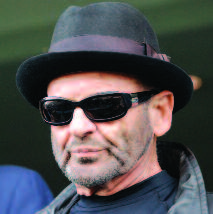
Photo by Yausser
Pesci continued to shine in both dramatic and comedic roles after Home Alone. He had memorable performances in JFK, My Cousin Vinny, Home Alone II, The Public Eye, Casino and The Super. By the late-1990s, the starring roles being offered to Pesci tended to be in low-brow or low-quality pictures, so in 1999 he decided to take a hiatus from the cinema and stage to revive and pursue his musical career

Hughes Entertainment/20th Century Fox
Daniel Stern (August 28, 1957) was born in Bethesda, Maryland, where he caught the acting bug as a teenager. He starred in several high-school productions and applied for a job as a lighting engineer for a Shakespeare Festival in Washington. Instead, he was hired as a walk-on in a production of The Taming of the Shrew, starring Glenn Close. Stern dropped out of high school in his senior year and soon moved to New York, where he found parts in Off Broadway and Broadway productions, including True West with Gary Sinise
In 1979, Stern made his film debut as Cyril in Breaking Away and had a small part in Woody Allen’s Stardust Memories a year later. His breakthrough role came in 1981 as “Shrevie” Schreiber, the obsessive-compulsive record collector, in Barry Levinson’s Diner. In 1985, he appeared in Woody Allen’s Hannah and her Sisters and in 1988 he began a six-season run as the adult voice of Kevin Arnold in The Wonders Years. After playing Murchens in Home Alone, Stern played Phil Berquist in City Slickers and City Slickers II and directed the baseball film Rookie of the Year. Recently, Stern played nuclear physicist Glen Babbit in 15 episodes of the critically acclaimed series Manhattan, about the building of the atomic bomb during World War II. He also directed two episodes.
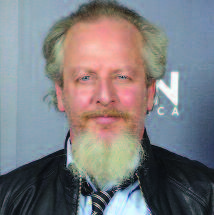
Courtesy of Mingle Media TV
Stern is an accomplished fine artist, particularly in bronze sculpture. He has created works for public art projects in San Diego, Pasadena, Palm Desert, Temple City and Agoura Hills, as well as many private commissions, gallery exhibitions and art fairs. He is currently an artist in residence at Studio Channel Islands Art Center in Camarillo, California. His brother is television writer David M. Stern, and his son is California State Senator Henry Stern.
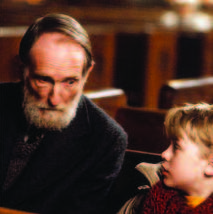
Hughes Entertainment/ 20th Century Fox
Roberts Blossom (March 25, 1924 – July 8, 2011), who played Old Man Marley—Kevin’s next door neighbor in Home Alone—was born in New Haven, Connecticut. His father, Robert, was Athletic Director at Yale. Blossom grew up in Cleveland and attended Harvard for a year before enlisting in World War II. After the war, he found his way into acting and earned high praise from critics during the 1950s, 1960s and 1970s—winning an Obie in each decade. Blossom worked steadily on and off Broadway, as well as appearing in numerous television series and soap operas, in which he often played villains
Beginning in his 40s, Blossom began playing eccentric and cantankerous old oddballs on the silver screen, with roles in Slaughterhouse Five, The Great Gatsby, Close Encounters of the Third Kind, Escape from Alcatraz, Doc Hollywood, Christine, The Last Temptation of Christ and The Quick and The Dead
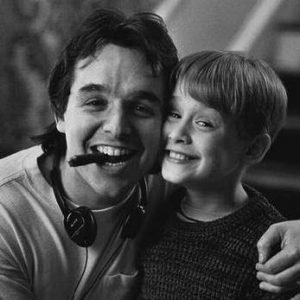
Hughes Entertainment/ 20th Century Fox

20th Century Fox
Chris Columbus (September 10, 1958) was born in Spangler, Pennsylvania and raised in the Ohio town of Champion. He attended New York University’s film school at the Tisch School of the Arts, where he was classmates with writer/director Charlie Kaufman and actor Alec Baldwin. Columbus neglected to renew his scholarship after his freshman year and had to work a factory job back home to afford his sophomore year tuition. In between shifts he worked on his first screenplay, which would become the hit movie Gremlins. Steven Spielberg optioned it and also hired Columbus as a screenwriter. He wrote two more scripts for Spielberg—The Goonies and Young Sherlock Holmes—and made his directorial debut in 1987, with the teen comedy Adventures in Babysitting. John Hughes wanted Columbus to direct National Lampoon’s Vacation, but Columbus didn’t see eye-to-eye with Chevy Chase and did not get the job. Hughes saw to it that Columbus was on Home Alone.
After Home Alone, Columbus directed a dozen more movies, including Home Alone II, Mrs. Doubtfire, Stepmom, Harry Potter and the Sorcerer’s Stone, Harry Potter and the Chamber of Secrets, and Pixels. In 1995, he founded 1492 Pictures and produced Harry Potter and the Prisoner of Azkaban and The Help, for which he received an Academy Award nomination.
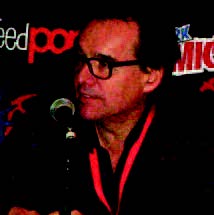
Photo by Nightscream
Like Hughes, Columbus embraced the ethos of directors like Frank Capra. “I can understand the validity of showing people the ugliness of the world,” he once said, “but I also think there is a place for movies to leave people with a sense of hope. If your film isn’t going to do that, I just don’t think it’s worth making.”
The not-so-funny side of Home Alone
By Sarah Rossbach
One September day, when my near-twin children were entering high school, I ran into a distressed, grief-stricken acquaintance at the local farm market. In tears, the normally perky, upbeat woman shared that her youngest had just left for college. She was an empty-nester and life as a mother was over. While her child was adjusting to the freedom and challenges of college life, she was mourning the end of family dinners, high-school tennis matches, and a house full of laughing teenagers. One look at the abandoned bedroom, the discarded racket and lunch box and it was too much to bear. Now retired from her role/job as an active parent, she had contracted a full-blown case of Empty Nest Syndrome: The helicopter parent had landed with a lonely thud and an empty tank.
Fast-forward a few years. My husband and I dropped off our two at their respective New England colleges—as luck would have it—a day apart. In spite of loving our children dearly, I was determined to avoid my acquaintance’s pitfall. I reminded my spouse that we’d had a lot of fun before we had children and suggested viewing their absence as a sort of second honeymoon. He didn’t quite carry me over the threshold, but we found that being home alone together gave us more quality time for each other. While we weren’t exactly celebrating that we were “free at last,” we took solace that the kids were in college, a parenting job well-done.
 Everyone has “helpful” suggestions on parenting, but how does one deal with un-parenting—losing one’s identity as a mom or dad, being on one’s own and becoming a temporarily child-free individual or couple? Wikipedia describes the Empty Nest Syndrome (ENS) as a “feeling of grief and loneliness parents may feel when their children leave home for the first time, such as to live on their own or to attend a college or university.” It is not a clinical condition, yet its symptoms can range from depression and loss of purpose to stress and anxiety about the child. Of course, for some, the departure of a “difficult” child may not come soon enough.
Everyone has “helpful” suggestions on parenting, but how does one deal with un-parenting—losing one’s identity as a mom or dad, being on one’s own and becoming a temporarily child-free individual or couple? Wikipedia describes the Empty Nest Syndrome (ENS) as a “feeling of grief and loneliness parents may feel when their children leave home for the first time, such as to live on their own or to attend a college or university.” It is not a clinical condition, yet its symptoms can range from depression and loss of purpose to stress and anxiety about the child. Of course, for some, the departure of a “difficult” child may not come soon enough.
COPING
 My father had a saying about his kids: “If you’re going to raise eagles, you have to let them fly.” The message (I think) was his rationalization as he sadly watched us go in different directions, as well as being his way to encourage and inspire us: that separation from one’s parents was a key inaugural element to launch one’s life journey.
My father had a saying about his kids: “If you’re going to raise eagles, you have to let them fly.” The message (I think) was his rationalization as he sadly watched us go in different directions, as well as being his way to encourage and inspire us: that separation from one’s parents was a key inaugural element to launch one’s life journey.
I reached out to Dr. Rodger Goddard for some advice to parents whose eagles have flown the coop. Dr. Goddard is Chief Psychologist and Director of Wellness Management Services at Trinitas Regional Medical Center. (Wellness Management Services provides presentations, programs and consultation to help corporations and schools achieve their key goals.) Empty Nest Syndrome (ENS) is extremely common, he points out. In fact, as many as 30% of all Baby Boomers may experience this syndrome.
“The range of experiences that a parent may have are extremely varied,” he explains. “A child may have moved only a block away or to the other side of the country. A child or parent may not blink an eye or one may experience very intense emotional swings during this transition. A significant number of parents struggle with ENS. The classic symptoms range from feelings of loss, depression and meaninglessness to high anxiety and intense worry.”
Dr. Goddard offers a number of strategies that can help alleviate this potentially painful and difficult time. There are two key areas that parents can work on to build skills to help get through this challenging life transition…
IMPROVE THE RELATIONSHIP
First, focus on finding ways to positively change your relationship with your child. Your child is likely to have very mixed feelings about the separation: torn between wanting to still feel protected, loved and secure, while rejecting being treated like a child. This may send a parent very mixed messages, resulting in a parent being torn between giving advice, criticism and help, and feeling mistreated and pushed away.
Second, it is important to find a balance of contact during this time. While you want to avoid suffocating your child and giving him or her the message that they are incapable of being on their own, your child still needs your help. Figure out with your child the best form and frequency of contact; text, email, phone, visits. Avoid being too invasive at this time. This would send the message that your child cannot manage on his or her own. Yet too much distance would communicate to your child that you disapprove of their separation and independence, potentially implying you are withdrawing your love and support because they have a new place to live, a new job, a new partner, and so on. It is critical to show support and love during the transition into college, and beyond, as it can be extremely scary and anxiety-filled for a child dealing with separating from the family. In short, you may be most effective when you encourage independence, yet still show your intense love and support, and provide advice and direction when needed. Remember to not distance yourself too much no matter how much upset, anxiety, relief or sadness you are feeling in order to create a good balance. Your child needs you to be in the dual role of both a guiding, advice-giving parent and a supportive, affirming, accepting friend in the background.
OPPORTUNITY FOR SELF-CARE & GROWTH
You have devoted your whole life to nurturing this beautiful child and are likely to experience a loss of meaning and purpose when your child is separating. It is a wonderful time to devote yourself to something new. According to Dr. Goddard, a good antidote to the loss of meaning and purpose is to use this time to build your self-esteem and explore new meaning in your life. Supporting yourself begins with using techniques to control your anxious, worried thoughts. Learn to be calm, practice deep breathing exercises all day long. Focus on rational thoughts and be more active. Use the time to do a life review to clarify the mission and purpose of your life and find new directions to focus what you have to give the world.
HOME AGAIN
In the spirit of full disclosure, I should mention at this point that, having coped reasonably well with ENS, my husband and I are now faced with another challenge about which you’ve probably read or heard. As of this writing, my eagles have both come home to roost and are part of the Boomerang Generation. Parenting has become trickier, as you’re all cooped up again and you, as parent, are dealing with young adults who have tasted and enjoyed their own independence. This issue is complex. Life is much more challenging now, it is more difficult to find a job than in the past and renting or buying on one’s own is more expensive than ever. For example, my kids are working full-time, but can afford only to live at home for now.
So Empty Nesters, you may want to hold off on converting those freed-up bedrooms into home offices or man caves.
NOT-SO-EMPTY NEST
Somewhere around a one-third of 18-to-34-year-olds are living at home with their parents, due, in part, to financial challenges. Dr. Rodger Goddard offers these thoughts to Boomerang parents:
- Today, children are less mature, independent and self-reliant compared to earlier times. This may potentially be a result of Baby Boomers being overly supportive, indulging and spoiling their children, compared to past generations. As a result, many of those in their 20s are like teenagers and those in their 30s are like those in their 20s.
- Children returning home and living with their parents can be very difficult for both parent and child. Parents are likely to want to parent the same way they did for the last 20-30 years. As the child has been away from home for the college years, anger and resentment can arise in the boomerang child who feels independent and resents being treated like a kid.
It is best for everyone that the relationship evolves. For all to live happily under the same roof, it is critical that there is a working structure in place, that all understand their responsibilities: chores, rent, behavior and so on. So all need to agree on a set of guiding rules: who does what, when and where. A written agreement concerning key issues—as well as a plan for the child transitioning to being on his or her own—is critical.
How much is enough? How much is too much?
By Christine Gibbs
Don’t Bother, Homework Is Pointless. When this headline ran in The New York Times during the 2014–15 school year, you could practically hear the jubilant roar of elementary school students and their parents. Imagine a world without nightly assignments. No more badgering. No more meltdowns. Utopia. The writer cited research that almost universally drew the same conclusion: Homework in the K-thru-8 world is practically pointless.
 Three years later, despite mounting evidence that a 20th Century approach to homework does not adequately address the needs and challenges of the 21st, the war between those in favor of homework and those against it rages on. The anti-homework faction has amassed a mountain of newspaper stories like the one in the Times and can also cite serious studies, with statistically significant results, published in countless treatises and on endless websites. For example, research performed at Stanford University found that among 4,300 students in high-achieving California communities, those who spent two hours on homework experienced more stress, physical health problems, lack of balance, and even alienation from society.
Three years later, despite mounting evidence that a 20th Century approach to homework does not adequately address the needs and challenges of the 21st, the war between those in favor of homework and those against it rages on. The anti-homework faction has amassed a mountain of newspaper stories like the one in the Times and can also cite serious studies, with statistically significant results, published in countless treatises and on endless websites. For example, research performed at Stanford University found that among 4,300 students in high-achieving California communities, those who spent two hours on homework experienced more stress, physical health problems, lack of balance, and even alienation from society.
A few daring school districts have been brave enough to implement a no-homework policy in the lower grades, which prompted a visceral reaction from many parents (and even some teachers) who feared it would affect everything from test scores to future college acceptances.
In 2014, sociology professors Keith Robinson and Angel L. Harris authored a book that has become required reading in certain circles entitled The Broken Compass: Parental Involvement with Children’s Education. They present extensive and credible evidence that homework doesn’t help much, if at all. Another conclusion of their research was that parental meddling in homework assignments can actually bring test scores down. This kind of interference, common among today’s helicopter parent population, “could leave children more anxious than enthusiastic about school.” The Race to Nowhere, a 2011 documentary produced by Vicki Abeles—a well-known filmmaker, speaker, and children’s advocate—featured interviews with burned-out students from our own Garden State schools who reveal how too much homework is often detrimental, especially in the early grades. The final conclusion of her film is that “the only homework that actually helps kids learn is reading… just reading.”
 So does homework work? Yes, say its proponents. A robust homework regimen has lasting real-world benefits. In her 2011 article, entitled “Why Homework is Good for Kids,” education historian Diane Ravitch pointed out that a little- or no-homework policy is likely to result in students who do not read much, do not write well, or don’t complete assignments. She sums up her defense of homework as follows: “[It] doesn’t help students who don’t do it, but very likely does help students who actually complete their assignments. Duh.”
So does homework work? Yes, say its proponents. A robust homework regimen has lasting real-world benefits. In her 2011 article, entitled “Why Homework is Good for Kids,” education historian Diane Ravitch pointed out that a little- or no-homework policy is likely to result in students who do not read much, do not write well, or don’t complete assignments. She sums up her defense of homework as follows: “[It] doesn’t help students who don’t do it, but very likely does help students who actually complete their assignments. Duh.”
While researchers haggle over the merits of the day-to-day payoff of homework, longtime educators point out facts that are difficult to dispute. Taking homework seriously—i.e. doing it well and doing it neatly (not in the back of the car or wedged into a subway seat)—develops habits for life. One of the great complaints employers have is that a high percentage of their workers do not understand expectations or how to meet expectations, and that accountability seems like a foreign concept. This is true of fast-food workers, Ph.D.’s and everyone in between. Homework helps young people comprehend responsibility and the value of a job well done.
 Who makes decisions about homework? Schools typically have a policy on time limits. For younger kids, it’s often a half-hour a night—increasing to 90 minutes or more by middle school, as they have more subjects and become more mature. In most cases, the type and quality of homework is discussed on the division level. The focus is on elevating the students’ cognitive skills.
Who makes decisions about homework? Schools typically have a policy on time limits. For younger kids, it’s often a half-hour a night—increasing to 90 minutes or more by middle school, as they have more subjects and become more mature. In most cases, the type and quality of homework is discussed on the division level. The focus is on elevating the students’ cognitive skills.
Our federal government has long been a proponent of the benefits of homework as part of any good curriculum. Through programs such as No Child Left Behind, countless millions of dollars were aimed at ways to improve education—almost all of which emphasized homework as a valuable teaching tool. Such programs unfortunately fell short of their goals through inefficiency at the state level. As these programs failed, so did the undisputed confidence in the rewards of a hefty homework regimen.
 Many experts feel that homework strategies have failed to keep pace with the digital age. Finding answers is often a button-click away, while collecting information is like trying to drink out of a fire hose. The gates to knowledge have been flung wide open and, yet, when a child sits in front of a screen, there is no gatekeeper. Interestingly, upper grade homework has remained roughly the same since 1984—a bit under two hours—but what fills that time is, in many cases, dramatically different today than in the ‘80s. Some believe development of an Intelligent Tutoring System (ITS) will “replace” homework. An ITS is a computer program that gives students customized instruction and feedback in real time, with oversight by a teacher. These programs are becoming more prevalent in professional settings and may eventually find their way down to the grade school level.
Many experts feel that homework strategies have failed to keep pace with the digital age. Finding answers is often a button-click away, while collecting information is like trying to drink out of a fire hose. The gates to knowledge have been flung wide open and, yet, when a child sits in front of a screen, there is no gatekeeper. Interestingly, upper grade homework has remained roughly the same since 1984—a bit under two hours—but what fills that time is, in many cases, dramatically different today than in the ‘80s. Some believe development of an Intelligent Tutoring System (ITS) will “replace” homework. An ITS is a computer program that gives students customized instruction and feedback in real time, with oversight by a teacher. These programs are becoming more prevalent in professional settings and may eventually find their way down to the grade school level.
Harris Cooper, a Duke psychology professor, points out that people have been arguing about homework for a century. “The complaints are cyclical,” he says, “and we’re in the part of the cycle now where the concern is about too much.”
Cooper adds that, back in the 1970s, the focus in American schools was on too little homework because we were more worried about global competitiveness. Wherever we stand as a parent or educator, we should prepare for the homework pendulum to continue to swing. But for now, although homework doesn’t appear to be all it was once cracked up to be, Do your homework! still resounds in many a U.S. household.
In the end, wherever you come down on the homework debate, and regardless of which mega-study you believe, there is one point all educators agree on—and cannot stress enough to parents—which echoes the conclusion of The Race to Nowhere: The single most important thing a child can do outside of school is read. Whether it is done for an assignment or as an escape, reading helps young people develop a sense of grammar and spelling, exposes them to new ideas, sparks the imagination and helps instill in them an intuitive understanding of communication.
 MAKING HOMEWORK WORK
MAKING HOMEWORK WORK
As principal of the Benedictine Academy in Elizabeth, Ashley Powell is all too familiar with the battle of contention that has been raging for the past 10 years or so about the pros and cons of homework. She takes a structured approach on the “pro” side. For Powell, there is no value in simply requesting a review of what went on that day in the classroom:
“No busywork for homework…instead, I favor extending exploratory learning of subject matter through project and research assignments, rather than rote memorization.”
“There is just too much available online,” she adds, “so assigned topics can simply be Googled and regurgitated
“The key to making homework work for teachers (and students) is to know why they are assigning each night’s homework and to make sure it serves a valuable purpose.”
 THE SWEET SPOT
THE SWEET SPOT
Finding the right balance of homework is a constant challenge, says Jayne Geiger, Head of School at Far Hills Country Day for 22 years and now Interim Head at The Rumson Country Day School. “We want children to take homework seriously, to think and reflect and produce their best work,” she says. “Yet we don’t want to overburden or overpressure them, especially with all of the outside-of-school activities students have now. We’re always looking for that sweet spot.”
 Homework is a valuable tool, Geiger adds.
Homework is a valuable tool, Geiger adds.
“With younger children, it is used as an assessment tool. It helps us make sure that students understand the lesson. It reinforces what they’ve learned and gives them time outside the classroom to practice. For older kids, homework focuses more on context and application. Students might be asked to write an opinion on a topic discussed in class, work communally on a Google Doc, edit something they have already written, or do individual research and produce an original thought.”
For all ages, Geiger says, homework establishes good habits, including responsibility, organization and preparation. It also enables students to develop and practice their executive functioning skills.
But never forget, she adds, that reading “is still the best medicine!”
Jack Perrone comes home to New Jersey.
By Ghilianie Soto

There is something humbling about Dr. Jack Perrone. He exudes a calming energy that allows patients to open up and share concerns they may have pertaining to their health. It could be that Trinitas Regional Medical Center’s newest obstetrical surgeon is from the Midwest and brings a friendly demeanor and charm to the workplace. One thing’s for sure: His passion for women’s health has made him an asset in the community.
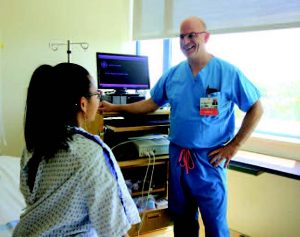 Though born and raised in Minnesota, Dr. Perrone is no stranger to the Garden State. He made his first New Jersey connection in college, graduating from Rutgers and receiving his medical degree from the University of Medicine and Dentistry of New Jersey (UMDNJ). He completed his residency at the Mayo Clinic School of Graduate Medical Education and has been practicing obstetrical gynecology for 21 years. He led his own private practice in Rochester, Minnesota as part of Olmstead Medical Center, a not-for-profit organization serving southern Minnesota.
Though born and raised in Minnesota, Dr. Perrone is no stranger to the Garden State. He made his first New Jersey connection in college, graduating from Rutgers and receiving his medical degree from the University of Medicine and Dentistry of New Jersey (UMDNJ). He completed his residency at the Mayo Clinic School of Graduate Medical Education and has been practicing obstetrical gynecology for 21 years. He led his own private practice in Rochester, Minnesota as part of Olmstead Medical Center, a not-for-profit organization serving southern Minnesota.
“I wanted to come back to the East Coast for the second phase of my career,” says Dr. Perrone. “Once I met the delightful people at Trinitas and saw the potential for growth here, there was no question this is where I belong.”
At Trinitas Regional Medical Center, the birthing facilities offer a modern maternity unit with private accommodations. The labor, delivery and recovery rooms Trinitas participated in the American Heart Association’s Little Hats, Big Hearts program to empower new moms to live heart-healthy while raising awareness of congenital heart defects.

Trinitas participated in the American Heart Association’s Little Hats, Big Hearts program to empower new moms to live heart-healthy while raising awareness of congenital heart defects.
are decorated to approximate a homelike atmosphere, and allowing mothers to remain in one room throughout the birthing process. State-of-the-art facilities and skilled staff of experienced obstetricians, anesthesiologists, neonatologists, midwives, and nurses are available in-house, 24 hours a day, and ensure the best possible care for mother and child.
Dr. Perrone enjoys delivering babies and taking care of women through pregnancy, childbirth, and the postpartum period. Trinitas’s maternity services include Labor & Delivery, an Intermediate Care Nursery, and a Mother-Baby Unit. A Level II Nursery offers sophisticated technology and treatment for ill and high-risk infants who require concentrated care and attention. Trinitas also offers TOLAC (trial of labor after cesarean) for women who desire vaginal delivery after a prior cesarean section.
“One of the best things about being part of the Trinitas network is working so closely with my medical and nursing colleagues to help educate our patients and the community,” he says. “Being a resource is an important piece of what makes the work I do so meaningful.”

www.istockphoto.com
Trinitas has worked to advance care by eliminating the element of the unknown and offering a variety of courses in preparing for parenthood, including “Labor, Delivery & Recovery,” “Breast Feeding” and “Caring for Your Baby.” New to their services is a partnership with The Baby Box Company. Through this special initiative, parents who complete the learning module on “safe sleeping” for their newborn receive a box filled with premium products and information on safe sleeping habits. Partnerships like these furnish parents with education and resources to give their babies a safe start in life.
With two daughters of his own, Dr. Perrone understands the importance of making sure parent and child receive the necessary resources and tools to lead healthy and happy lives.
Whether you use them or not, having the right tools for any job is a key to being a responsible homeowner.
By Caleb MacLean
One day this past spring an unfamiliar urge swept over me as I glanced up at the side of my old, wood-shingled home. One of the two local woodpecker kabbalahs (I think it was the smaller downy woodpecker) had taken a shine to our siding and punched a series of perfectly round holes above our second-story bedroom window. Presumably the birds were hearing something on the other side of the shingles that they assumed were bugs. Since I often experienced their pecking while watching Morning Joe before work, I think what they were hearing was Mika Brzezinski stressing out about President Trump.
Anyway, on this particular day I decided enough was enough…I was going to yank out the damaged shingles and replace them myself. I would not call a professional.
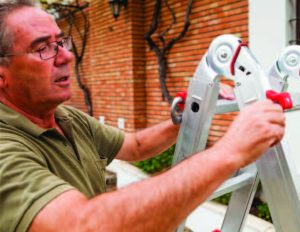 I mean, how hard could it be?
I mean, how hard could it be?
It was hard.
I knew having the right tools was important, although I wasn’t sure exactly which tools this job required. I dug out our toolbox and searched the Internet for some instructional clips on replacing damaged shingles. The tools in my box looked enough like what the guys in the videos were using. Next, I needed a good ladder.
About a week later my ladder arrived via UPS—nothing like striking while the iron is hot, right?
I had ordered one of those Little Giant contraptions you see advertised on late-night TV. It did so many jobs and, even though none of those jobs were ones I was likely to perform, I’m all about versatility. So 200-plus dollars later I unboxed my new ladder, read the instructions carefully and then came within a half-inch of losing my pinkie trying to unfold it. I re-read the instructions (oh, okay, I see) and did it correctly this time. With my toolbox at the ready, I maneuvered the ladder under the first hole, tilted it up against the house…and realized that it was five feet short of what I needed.
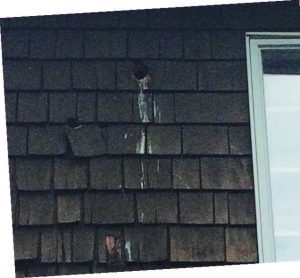 Starlings soon moved into the woodpecker holes, raised their noisy children, and defecated all over the side of the house. I think some kind of bees are in there now.
Starlings soon moved into the woodpecker holes, raised their noisy children, and defecated all over the side of the house. I think some kind of bees are in there now.
This is not a story about buying the wrong ladder. I can (and may very well) write a book on the subject if I manage to keep all 10 fingers intact. It’s about the things every man—handy or, like me, un-handy—needs in his toolbox. I am being gender-specific here not out of laziness or chauvinism, but because the women I know would already have found a better version of this article and assembled a great toolbox. Or called a professional long before the wildlife assault had transitioned into an infestation.
What do you absolutely, positively need in a toolbox? As an amateur repairman with a hard emphasis on amateur, I have managed over the better part of four decades to assemble a pretty good one. If you’ve covered the basics with quality equipment, you should be able to tackle almost any project that doesn’t involve water or electricity. So let’s take a peek inside and see what you’ve got, and what you might still need…
SCREWDRIVERS
 There are four basic types of screwdrivers: slotted, Phillips, square drive and precision. You should have a variety of sizes, including a couple with extra-long shafts. The market is flooded with inexpensive sets made of poor-quality metal and, speaking from experience, I’ll just say that you get what you pay for. Over the years, I can’t tell you how many screwdrivers I have dulled or destroyed wrestling with uncooperative screws. Sometimes the screws are made of inferior metal, which is even more infuriating.
There are four basic types of screwdrivers: slotted, Phillips, square drive and precision. You should have a variety of sizes, including a couple with extra-long shafts. The market is flooded with inexpensive sets made of poor-quality metal and, speaking from experience, I’ll just say that you get what you pay for. Over the years, I can’t tell you how many screwdrivers I have dulled or destroyed wrestling with uncooperative screws. Sometimes the screws are made of inferior metal, which is even more infuriating.
If you do feel like buying a cheap screwdriver, grab one of those 4-in-1 jobs you often see in the impulse-purchase section of your local hardware store for $5. You know the ones I’m talking about: they have two flat-heads and two Phillips heads, and you can pop them out of the handle and spin the shaft around to get the head you need. Go ahead and buy three because a) a little bit of torque can render them useless and b) like scissors and socks, they tend to vanish. I also like to have a couple of sets of those L-shaped Allen wrenches in my box. I keep them on a keychain. I know they are called wrenches, but to me they are screwdrivers. Technically, they are called hex keys.
I’ve always wondered which came first—the Phillips screw or the Phillips head screwdriver. This may be more of a philosophical debate than a technical one. I imagine they were equal parts of the same burst of inspiration. What I do know is that the Phillips screw is favored by manufacturers because it is self-centering. And I recently learned that neither the screw nor the screwdriver was invented by Phillips. John P. Thompson came up with the idea during the Depression and sold it to Henry F. Phillips, who added a couple of tweaks and then convinced GM to use his screws in its Cadillac production line. Next I’m sure you’re wondering, did Allen invent the Allen wrench? Yes! Just over a century ago, the Allen Manufacturing Company came up with a recessed “safety” screw that required its special wrench to tighten and untighten. Allen sold the patent to a company called Apex Tool Group. Apparently, Apex is slowly being driven mad by the fact that people won’t stop calling their tool by another company’s name.
HAMMERS
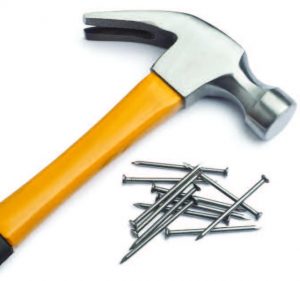 If you ask my wife, who does all the picture-hanging in our home, my recommendation for hammers would be a wide assortment of sizes and weights with rusty heads and deteriorating wooden handles. That is because I’ve been hiding the good ones from her. And by good ones I mean the $20 beauty I purchased after my Chinese-made, fiberglass-handled hammer literally broke in half while I was prying a long nail our of an old table. So here is what I have to say about hammers: Buy one made from a single piece of steel, not too light, not too heavy—about a pound give or take an ounce—with a curved claw for basic nail removal. A $20 to $30 hammer should also have a fairly ergonomic grip and will feel balanced in your hand. Balance is the key to good aim, i.e. hitting the nail on the head and not your thumb. The striking surface should be about an inch wide.
If you ask my wife, who does all the picture-hanging in our home, my recommendation for hammers would be a wide assortment of sizes and weights with rusty heads and deteriorating wooden handles. That is because I’ve been hiding the good ones from her. And by good ones I mean the $20 beauty I purchased after my Chinese-made, fiberglass-handled hammer literally broke in half while I was prying a long nail our of an old table. So here is what I have to say about hammers: Buy one made from a single piece of steel, not too light, not too heavy—about a pound give or take an ounce—with a curved claw for basic nail removal. A $20 to $30 hammer should also have a fairly ergonomic grip and will feel balanced in your hand. Balance is the key to good aim, i.e. hitting the nail on the head and not your thumb. The striking surface should be about an inch wide.
Some jobs (like my shingle experiment) may require different types and weights of hammer. Most people add them as they go. Eventually, you’ll probably want to have a club hammer and a pin hammer. A club hammer has a short handle and heavy head. It’s good for demolition projects and is also good for tapping a chisel. A light pin hammer can be used for small carpentry jobs and things like repairing picture frames. Two hammers you probably recognize, but are unlikely to need, are a ball peen hammer and a roofing hammer. Ball peen hammers (the “peen” is the non-striking side of the head) are a throwback to when regular people worked with metal. That’s no longer a thing. A roofing hammer is shaped to do a couple of jobs you’ll only need to do on a roof. It has a “spiked peen.” I hear there’s a pill for that now.
TAPE MEASURE
 Like a good hammer, a high-quality tape measure will run you between 20 and 30 bucks. For most folks, a 25-footer will do. Of course, whatever length you buy, you’ll soon need to measure something two feet longer, but that’s a life problem, not a tool problem. Most contractors like a tape measure that locks and unlocks easily, and “stands out” at least six feet—meaning it won’t collapse down when held straight out in the air. If you can find one with a magnetic hook, that’s a plus since you’ll probably be working alone. Obviously, you want to make sure your tape measure has easily read feet, inches, centimeters and meters. It should be shockproof and heavy-duty because you will drop it again and again and again. Look for some kind of replacement guarantee from the manufacturer.
Like a good hammer, a high-quality tape measure will run you between 20 and 30 bucks. For most folks, a 25-footer will do. Of course, whatever length you buy, you’ll soon need to measure something two feet longer, but that’s a life problem, not a tool problem. Most contractors like a tape measure that locks and unlocks easily, and “stands out” at least six feet—meaning it won’t collapse down when held straight out in the air. If you can find one with a magnetic hook, that’s a plus since you’ll probably be working alone. Obviously, you want to make sure your tape measure has easily read feet, inches, centimeters and meters. It should be shockproof and heavy-duty because you will drop it again and again and again. Look for some kind of replacement guarantee from the manufacturer.
DRILLS
 We used to own a drill that worked beautifully up to a point. It was fine for boring the myriad holes a homeowner requires, even through old lathework and knots in wood. Where it sometimes fell short was when we were using it to screw or unscrew something. It was just too big and too heavy. It was difficult to keep on a consistent 90-degree angle, and when it encountered a stubborn screw it torqued my arthritic wrist and elbow violently. I am no expert with a drill, but I can say that the next one I buy will be lighter and more compact without sacrificing power. I suggest you do the same.
We used to own a drill that worked beautifully up to a point. It was fine for boring the myriad holes a homeowner requires, even through old lathework and knots in wood. Where it sometimes fell short was when we were using it to screw or unscrew something. It was just too big and too heavy. It was difficult to keep on a consistent 90-degree angle, and when it encountered a stubborn screw it torqued my arthritic wrist and elbow violently. I am no expert with a drill, but I can say that the next one I buy will be lighter and more compact without sacrificing power. I suggest you do the same.
As we near that day, I’ll also have to decide between corded or cordless. Cordless seems like a no-brainer, but it’s a little tricky figuring out how much work you can do on a single charge. I would check ratings and comments from previous customers and testing services. Also, in my case, I am congenitally incapable of remembering which little converter goes with which small appliance. Fortunately, we have no end of grounded outlets inside and outside our home (thank you, obsessive former owner) so I’ve felt no pressing need to cut the cord. As for drill bits, buy two sets (one high-quality, the other inexpensive) because you’ll probably lose the one bit you desperately need on a Sunday evening when everything is closed.
 PLIERS
PLIERS
There are three basic types of pliers everyone should have in their toolbox: vise-grips, needle-nose and old reliable adjustables. Vise-grip (aka locking) pliers are ideal for multiple tasks. Because the adjustment mechanism is identical on all brands, the main point of differentiation being is the ease with which the pliers lock and, more importantly, unlock. Don’t be afraid to test them out and you’ll see the difference. Needle-nose pliers are ideal for twisting tasks or grabbing hold of things your fingers can’t. They also double as wire-cutters. Pick a pair that open and close smoothly, and that feel comfortable in your hand. A good pair will run you $10 to $20. Definitely spend the money for a great pair of adjustable pliers. You’re looking for quality, durability, comfort and ease of use. Go with a push-button model if you can find one and avoid pliers that are over 10 inches long.
OTHER STUFF
 You should definitely have a utility knife in your toolbox. Not a box-cutter, but a multifunction utility knife. It should feel good and safe in your hand. If a sliding blade makes you nervous, you can buy ones that fold up like a pocketknife, and vice-versa. Changing blades after a couple of jobs is a must, so make sure that you have a good supply and that swapping them out is simple. Just as important is a high-quality pry-bar. Besides pulling out nails, tacks and other items, it can help un-stick doors, windows and anything else that’s been painted over.
You should definitely have a utility knife in your toolbox. Not a box-cutter, but a multifunction utility knife. It should feel good and safe in your hand. If a sliding blade makes you nervous, you can buy ones that fold up like a pocketknife, and vice-versa. Changing blades after a couple of jobs is a must, so make sure that you have a good supply and that swapping them out is simple. Just as important is a high-quality pry-bar. Besides pulling out nails, tacks and other items, it can help un-stick doors, windows and anything else that’s been painted over.
I recently installed a wall mount for a 46-inch flatscreen without a stud finder. That’s because the stud was me!
 Of course, I might just as easily have destroyed the wall, the TV and the Stickley bookcase underneath it—all because I lacked a $5 gadget. A stud finder uses a magnet to locate the screws used to fasten the sheetrock to the vertical studs. I used the old tap-tap-tap method. Use the stud finder because there is a fine line between stud and moron.
Of course, I might just as easily have destroyed the wall, the TV and the Stickley bookcase underneath it—all because I lacked a $5 gadget. A stud finder uses a magnet to locate the screws used to fasten the sheetrock to the vertical studs. I used the old tap-tap-tap method. Use the stud finder because there is a fine line between stud and moron.
I did use a level for the TV project. Unfortunately, it was one of those free apps you download onto your iPhone. We reside in an older home that’s not exactly plumb, so I feel as if I didn’t get the wall mount exactly straight. Fortunately, the manufacturer included an adjustment screw on the mount itself. In my defense, my only other option was to use a level that was over a foot long and just too cumbersome. For my next project I think I will either add a laser level, which I’ve used with success as a volunteer outside my home, or a standard torpedo level.
Like most homeowners, I’ve got a hodgepodge of other items in my toolbox. Mostly weird things I’ve purchased on impulse or in anticipation of some project I’ll never get to. To many, buying a specialized tool for a specific project is half the fun. For me it’s half the battle. My feeling is why not fight the other half of the battle later (or never)?
THE BOX
Finally, just as there is always a right tool for the job, there is a right toolbox for the tools you own. Car guys have those great big red rolling carts. Masons, carpenters and electricians certainly have their own specialized equipment carriers. For Joe Homeowner, there are some basic rules to follow.
First, don’t buy anything plastic. These toolboxes are usually priced to sell and often look like a reject from the Transformers movies. After a certain amount of abuse, they just don’t hold up well. Also, if you want to be truly serious about home repair, by all means avoid the pre-packed, ready-to-go tool kits that come in their own snap-shut carrying case. If buying every tool you’ll ever need for $50 or $75 seems too good to be true, trust your judgment. It is. Unless you’re just starting adult life or are living in a dorm or studio apartment, bite the bullet and make a modest investment. A good, metal toolbox filled with the basic high-quality products required to do the bulk of home fix-it projects, is likely to run between $300 and $500.
As for me, I’ve probably invested somewhere in between those two figures and except for the 22-foot ladder that needed to be 27 feet, I feel adequately equipped to go to war with anything between my roof and my basement. There are some wrenches in my toolbox, so I can even do some minor plumbing.
Regarding the woodpecker issue, however, I decided to call a professional to plug my holes and repair my shingling. I’m not sure which creature in the nearby woods is eyeing these openings as a potential domicile, but I have no interest in finding out. For the record, I do plan to get my money’s worth out of the Little Giant. When the shingle guy gets here, I will configure the ladder so that I can use it as a bench. Which I will use to watch someone qualified fix my house.
WHAT’S IN MY BOX?
Dennis Corcoran • HG Edwards
- Which tool is worth spending the extra money on for the very best quality?
- We work with replacement windows and doors, so for us it’s the Multi Master Oscillating Saw. The saw vibrates and oscillates, allowing for precise cuts that are not feasible with traditional circular saws.
- What’s the one tool you’d never leave home without?
- A sturdy tape measure, like a Stanley Powerlock 16′. Windows are typically made to order, and are not returnable. When ordering windows, the first step—getting accurate dimensions—is the most important. Measure twice, cut once…because you can’t cut the window!
- What tool is most dangerous in the hands of an amateur?
- Circular hand and table saws. They need to be used with caution, and should not be used at all without the safety shields and guards provided. Proper training is essential, but many accidents still happen among experienced installers and carpenters due to carelessness. Many a finger has been lost to circular saws due to laziness or carelessness. Think before each cut.
HG Edwards sells, installs and repairs doors and windows. The company has been in business since the 1950s and will be relocating from Summit to a new expanded showroom this October, at 1280 Springfield Ave. in New Providence. (908) 273–3224 • hgedwards.com
SEE HERE
 It never hurts to have a good pair of safety goggles in your toolbox—no pun intended. They range in price from a couple of bucks for cheap dust and splash goggles to $20 and up for models with mouth shields. For jobs involving mist or dust or chemicals that might damage your eyes, look for goggles that form a “gasket” where they contact your face.
It never hurts to have a good pair of safety goggles in your toolbox—no pun intended. They range in price from a couple of bucks for cheap dust and splash goggles to $20 and up for models with mouth shields. For jobs involving mist or dust or chemicals that might damage your eyes, look for goggles that form a “gasket” where they contact your face.
Unless everyone in your home has perfect vision, you’ll want at least one pair that fits over eyeglasses. You’ll also want to have sizes to fit any children in the house, in case they want to “help” mommy or daddy on a project.
“Sea scallops from Barnegat Bay showed the kitchen at its height…it was another plate that neglected neither style nor substance.”
By Andy Clurfeld
A TOUTE HEURE
232 Centennial Avenue, Cranford
Phone: (908) 276.6600
Reservations and major credit cards accepted. Lunch: Tuesday through Friday from noon to 2 p.m. Dinner: Tuesday through Thursday from 5 to 9 p.m., Friday and Saturday from 5 to 10 p.m. Sunday brunch is served the last Sunday of the month from 10:30 a.m. to 1:30 p.m. There is a special “Second Saturday” dinner served from noon to 10 p.m. Prices: Bites and appetizers range from $3 for an oyster to $19. Entrees range from $35 to $45. Mussels pots are $16 for a half pot and $30 for a full pot with frites. Desserts are $10. BYOB.
They had me at the duck rillettes.
First, that this oh-so-French specialty was on tap. Next, that they were textbook: Duck meat, slow-cooked in duck fat till silky-tender, then shredded, salted, potted and topped with more fat, is preserved and released from captivity when the flavor of the duck has been oomphed to the nth degree, then presented with proper toasts to diners who miss the dish’s native Dordogne like Harry Connick Jr. misses New Orleans.
OK, I think to myself; you can go home again, even if the home fires aren’t being lit by the same ol’ folks.
A Toute Heure in Cranford, one of my favorite restaurants in all of the Garden State, may have a new chef and new owners, but the charms and sincerity of the plates coming out of its kitchen match that of founders Andrea and Jim Carbine, who sold the restaurant last spring.
Today’s proprietors, Nathally and Mario Florio, and their on-point chef Alexandre Gomes, also source locally and fanatically, but they bring a bit more of a cosmopolitan approach to the menu. Sure, there are the humble peasant-fare-gone-haute rillettes, but there’s also an asparagus duo that sings with a citified French accent:

Photos courtesy of A Toute Heure
Both white and green asparagus are employed, along with peppery greens, a coddled egg oozing golden yolk and dabs of bearnaise tickled with tarragon. Gomes then takes the pitch-perfect dish a step higher by sprinkling the pretty plate with bacon dust. Holy smoke! It’s a unifier.
Speaking of pretty plates, I hope the special salmon tartare makes regular appearances in A Toute Heure’s new lineup: The rosy-orange sushi-caliber fish, chopped and mounded amid peas and near-translucent slices of radish before being topped with microgreens, sits atop a thick wash of pea puree given a couple arcs of fruity olive oil for good measure. It was the dish that made it clear to me why the Florios hired Gomes as their chef. Finesse, top-notch technical skills and an acute awareness of how to bring nuance to a dish aren’t exactly qualities priced at a dime a dozen.
 Those same skills are evident in the soft-shell crab, expertly seared so the shells are crisp-tender, while the meat remains sweet-juicy. It gets a lift from two plate partners that offer a counterpoint to the flavor and texture of the dish: an aioli that resonates with musky, gently bitter saffron to offset the sweetness of the crab, and shavings of cucumber that do the crunch-squirt do-si-do just like the shellfish.
Those same skills are evident in the soft-shell crab, expertly seared so the shells are crisp-tender, while the meat remains sweet-juicy. It gets a lift from two plate partners that offer a counterpoint to the flavor and texture of the dish: an aioli that resonates with musky, gently bitter saffron to offset the sweetness of the crab, and shavings of cucumber that do the crunch-squirt do-si-do just like the shellfish.
The only dish we tried that fell short was the roasted chicken, billed to have been marinated in piri-piri. Piri-piri is a hyper-hot chile native to Africa that’s used in a Portuguese chicken dish that folks make pilgrimages to experience. It’s incendiary in that irresistible way, with waves of heat ebbing and flowing in the presence of, usually, garlic and vinegar or lemon. The chicken here, to be sure, was lovely, but the bird and the broccolini and the roasted potatoes sure would’ve been special with real-deal piri-piri heat.
Sea scallops from Barnegat Bay showed the kitchen at its height: Again, a textbook sear; again, perfect produce partners in baby carrots and discs of purple potatoes, as well as earthy shiitakes and delicate oyster mushrooms; again, a garnish that proves it’s more than a toss-off in fava leaves. It was another plate that neglected neither style nor substance.
 But what about mussels? A Toute Heure, the original, was known for its mussels pots, an ever-changing, ever-evolving repertoire of them. We indulged with the new “beurre fondue” mussels pot, a rich concoction bolstered by butter (lots), cream (lots) and leeks. This version’s statement-making, breakout ingredient is the addition of potent, but not overwhelming, garlic confit. (Fortunately, the billed “truffle” had little impact.)
But what about mussels? A Toute Heure, the original, was known for its mussels pots, an ever-changing, ever-evolving repertoire of them. We indulged with the new “beurre fondue” mussels pot, a rich concoction bolstered by butter (lots), cream (lots) and leeks. This version’s statement-making, breakout ingredient is the addition of potent, but not overwhelming, garlic confit. (Fortunately, the billed “truffle” had little impact.)
Salad for dessert? You bet. Grab it when it’s peach season and Gomes is grilling his peaches before tossing them with raspberries and blueberries, then topping them with the creamy Shy Brothers’ “cloumage” from coastal Massachusetts. A drizzle of honey, and you have just my kind of dessert. I have to admit, though, that I also was smitten with the ricotta cake, infused as it was with olive oil, plied with citrus and hazelnut, then plated with macerated cherries.
 For a decade, Andrea and Jim Carbine served New Jersey in exemplary style, creating a restaurant in A Toute Heure that paved the farm-to-table way for small, personal, bistro-style restaurants determined to educate, enlighten and, ultimately, elevate our expectations of what could be done in a casual, comfortable setting. Like good parents, they gave all they could – and then they let the next generation do their own thing.
For a decade, Andrea and Jim Carbine served New Jersey in exemplary style, creating a restaurant in A Toute Heure that paved the farm-to-table way for small, personal, bistro-style restaurants determined to educate, enlighten and, ultimately, elevate our expectations of what could be done in a casual, comfortable setting. Like good parents, they gave all they could – and then they let the next generation do their own thing.
Their chosen successors, chef Gomes and the Florios, aren’t just worthy; they are world class.
LET EVERYONE DRINK ROSÉ
 Never have I met a restaurant menu that begs for a French rose more than A Toute Heure’s. It’s possible that the menu served forth by the new regime begs for such a rosé even more forcefully. So much of what we ate, and so much of what we passed up on this first round at the new ATH, seemed made for rosé.
Never have I met a restaurant menu that begs for a French rose more than A Toute Heure’s. It’s possible that the menu served forth by the new regime begs for such a rosé even more forcefully. So much of what we ate, and so much of what we passed up on this first round at the new ATH, seemed made for rosé.
So now a bit of torture: My dine team for this dinner drank the most special wine I’ve ever brought on an eating mission—the 2015 Chateau Simone Rosé. Don’t expect to find it at any old wine shop or liquor store. It’s imported by Neal Rosenthal (Mad Rose), and not exactly in big-box-store quantities. Chateau Simone is in the Palette appellation, which is a teensy speck of a wine district within the mere spot of a wine region known as Bandol, which is known as the premier place in all of Provence (and the Cotes de Provence appellation) for rosé.
Quite simply, it’s the bee’s knees of rosé, many, many, many layered, nuanced, rich yet lyrical. It’s delicious, and its partnership with everything from the duck rillettes to the salmon tartare to the soft-shell crab to the asparagus—yes!—to the scallops and the mussels was exactly what the wine-food pairing thing is about.
New Jersey’s newest ER has just had an $18.7 million expansion that has cut the wait by two-thirds.
By Yolanda Navarra Fleming

Seven years ago at Trinitas Regional Medical Center’s Emergency Department (ED)—Union County’s busiest Emergency Room—the median wait was about 65 minutes. But now, treatment space has doubled after the $18.7 million renovations and expansion, which has whittled down the median wait time to about 18 minutes.
Gary S. Horan, FACHE, President & CEO at Trinitas, says he looks forward to September when the entire department will be completed and dedicated. “The physical space is very impressive, and is designed to more appropriately treat the families, children, and seniors who come to us for care,” says Horan. “Separate areas for each make the care very specialized and personal.”
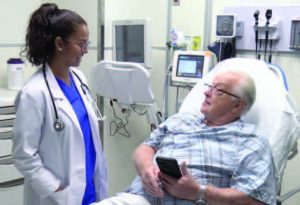 Geriatric patients will be seen in a separate, more serene area—with cosmetic and practical improvements and additions, such as mobility aids, pressure-reducing mattresses, bedside commodes, bedside transition stools, and the use of non-slip socks and hearing aids. Even the clocks on the walls are larger. But not only seniors will benefit from improvements and the 18 additional beds—including five private Geriatric beds, six Transitional Care Unit beds, and seven Fast Track Treatment bays. According to Dr. John D’Angelo, Chairman of the Emergency Medicine Department, the Geriatric ED has more to do with the complexity of care and less to do with age.
Geriatric patients will be seen in a separate, more serene area—with cosmetic and practical improvements and additions, such as mobility aids, pressure-reducing mattresses, bedside commodes, bedside transition stools, and the use of non-slip socks and hearing aids. Even the clocks on the walls are larger. But not only seniors will benefit from improvements and the 18 additional beds—including five private Geriatric beds, six Transitional Care Unit beds, and seven Fast Track Treatment bays. According to Dr. John D’Angelo, Chairman of the Emergency Medicine Department, the Geriatric ED has more to do with the complexity of care and less to do with age.
“Geriatric patients are not singularly defined,” says Dr. D’Angelo. “If a patient requires a multidisciplinary team to assist with preventing a hospital admission or facilitating a home care plan, they may find themselves in the Geriatric ED.”
For instance, a 50-year-old patient with advanced multiple sclerosis who requires full home care may benefit from Geriatric Care. In the ED, he or she may receive a physical therapy consult, a wound care consult, and a social worker, who reviews all home care needs.
Trinitas’s ED ranks among the top urban-based facilities of its size, processing about 70,000 patients each year.
 However, Dr. D’Angelo—who also serves as a tactical physician for the Union County Emergency Response Team and the SWAT Team—says, “Preparing for the unexpected is always a challenge. Patient arrivals on any given day at any given hour can be very dynamic. We are determined to answer the call through thoughtful staffing patterns and continued process improvement.”
However, Dr. D’Angelo—who also serves as a tactical physician for the Union County Emergency Response Team and the SWAT Team—says, “Preparing for the unexpected is always a challenge. Patient arrivals on any given day at any given hour can be very dynamic. We are determined to answer the call through thoughtful staffing patterns and continued process improvement.”
Dr. D’Angelo has been with Trinitas for the past five years. He attended Muhlenberg College and earned his bachelor’s degree in science before graduating from the Philadelphia College of Osteopathic Medicine. As chief resident in the Emergency Medicine Residency Program at Mount Sinai Beth Israel in New York City, he received both Resident and Researcher of the Year awards. After his residency, he moved to Florida and worked as an attending physician at regional trauma centers in South Florida. He also served as the Assistant Medical Director at several EMS agencies in Broward County.

The project includes three new state-of-the-art Intensive Care Unit rooms These rooms will help with the quick movement of patients who have been admitted to Trinitas through the Emergency Department.
Empathy has played an important part in his career.
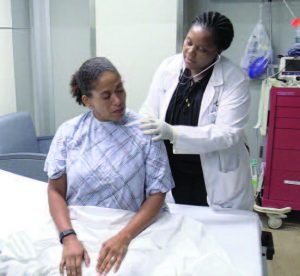 “Part of it is to see yourself within your patients,” he explains. “I see you; I am you. That’s critical in the delivery of the healthcare delivery system—to see yourself in the individual who is struggling.”
“Part of it is to see yourself within your patients,” he explains. “I see you; I am you. That’s critical in the delivery of the healthcare delivery system—to see yourself in the individual who is struggling.”
Delivering the same elevated level of healthcare to those who can’t afford it also drives him. “It’s always been my passion,” he says. “Top-notch care should be available to everyone. I urge those who can afford healthcare to support the mission and to help those who have less.”
“Fast Track,” or “Prompt Care,” is essentially an urgent-care or office visit, he says. “Our goal is to treat and release a patient in less than 90 minutes. Many patients find it challenging to find a primary care physician who accepts Medicaid, but we see any patient regardless of ability to pay.”

A 128-Slice CT scanner, located within the new Emergency Department, improves quality and further reduces wait time.
Patients with behavioral health or substance abuse issues can rely on the Transitional Care Unit (TCU) at Trinitas. For instance, a patient with Bipolar disorder co-occurring with opioid addiction is better served in the more controlled environment of the TCU, designed for patients who may have mixed disorders. Such patients may be considered “friendly faces,” says Dr. D’Angelo, “which are common in many urban emergency departments.”
The recovery specialist reaches out to such patients in the Trinitas ED and offers help and encouragement. Recently, a “friendly face” who struggles with alcohol addiction kept returning to the ER.
 “Our recovery specialist encountered the patient when he was sober,” Dr. D’Angelo recalls. “They made arrangements to meet at a McDonald’s for a free breakfast and coffee. The patient’s only obligation was sobriety.”
“Our recovery specialist encountered the patient when he was sober,” Dr. D’Angelo recalls. “They made arrangements to meet at a McDonald’s for a free breakfast and coffee. The patient’s only obligation was sobriety.”
The result of that happy meal has since turned into 15 days of recovery for the patient, who is continuing to do well. “To some that may not seem like a long time, but it’s a lifetime to this patient and more importantly a second chance.”

John D’Angelo, DO
Chairman/Emergency Medicine
Trinitas Regional Medical Center
News, views and insights on maintaining a healthy edge.
 Four Months or Twelve?
Four Months or Twelve?
A study published in the June edition of Pediatrics appears to be at odds with long-accepted recommendations by the American Academy of Pediatrics concerning how long infants should sleep in the same room as their parents. The new study indicates that four months may be the ideal cut-off. Beyond that point, babies sharing the same room get less sleep and sleep for shorter stretches. Also, the study suggests that between four and nine months, parents may be more likely to engage in unsafe sleep practices associated with sleep-related deaths. More than 3,500 infants die in sleep-related deaths in the U.S. each year. The lead author of the new study, Dr. Ian Paul, has an explanation for the difference between the two recommendations: AAP’s is based on a consensus of expert opinions, while the four-month cutoff is based on data from the study’s 230 families. He adds that moving a child out of the parent’s bedroom at one year is impractical for another reason—this tends to be a peak period of separation anxiety for children.
 Home Care of Alzheimer’s Patients On the Rise
Home Care of Alzheimer’s Patients On the Rise
According to a June report by the CDC, the number of deaths in the U.S. attributed to Alzheimer’s disease more than doubled between 1999 – 2014, from 44,536 to 93,541. The startling rise can be attributed to a number of factors, including greater longevity and aging Baby Boomers, as well as better diagnosis of the neurodegenerative condition. What’s most troubling about the results of the CDC report is that an increasing number of Alzheimer’s deaths are occurring at home as opposed to in hospitals or long-term care facilities. This suggests that families are having to assume the burden of caregiving, presumably for financial reasons. The long-term economic and mental health impact of this trend further complicates the Alzheimer’s picture.
 Is Vaping Worse for You Than Smoking?
Is Vaping Worse for You Than Smoking?
The ongoing debate around the growing use of e-cigarettes has some concerning new data, courtesy of a University of Connecticut study that appeared recently in ACS Sensors, a publication of the American Chemical Society. A team of UConn chemists looked specifically at DNA damage and found that electronic cigarettes loaded with nicotine-based liquid were potentially as harmful to DNA as unfiltered cigarettes like Lucky Strikes, while non-nicotine e-cigarettes carried the same risk as smoking traditional filtered cigarettes. The team focused on cellular mutations caused by DNA damage, which can lead to cancer. The concerning results were attributed primarily to the number of chemical additives in e-cig vapors, including propylene glycol, glycerin and nicotine, as well as flavorings.
Oh, Baby: Screen Time Linked to Delayed Speech
Are smartphones making kids dumber? The Hospital for Sick Children, located in Toronto, asked nearly 1,000 families to track the screen time of their young children, from six months to two years old. About one in five children 18 months or older used a tablet or smart phone for an average of 28 minutes a day. Within that group, every 30-minute increase in screen time was associated with a 49 percent increase in delayed speech. The American Academy of Pediatrics advises that children under 18 months have zero screen time, aside from video-chatting with family members.
 Easy On the Knees
Easy On the Knees
Go ahead and add one more benefit from fiber. An article published in the Annals of the Rheumatic Diseases reported that individuals who consumed a high-fiber diet had a dramatically lower incidence of knee arthritis. The article referenced two recent studies covering a total of 6,064 subjects. One found a 30%difference in osteoarthritis of the knee between the people who had the highest fiber intake and the lowest, while the other showed a 61% drop! There doesn’t appear to be a direct fiber-knee link; instead, researchers believe the benefit is related to weight control and inflammation associated with some lower-fiber diets. Of course, high-fiber diets have been directly linked to improved cardiovascular health, as well as a reduced risk of diabetes.
 Pedaling Toward Happiness
Pedaling Toward Happiness
Low pay, high pressure and shifting office politics can make for a toxic mix in our jobs. Indeed, nearly one-third of U.S. workers report suffering from chronic stress directly related to their employment, while 36% of those reporting stress say their company offers nothing in the way of stress management. A recent article in the International Journal of Workplace Health Management offered one solution: cycling to work. Those who bike—as opposed to commuting by car or public transportation—reported a significantly lower amount of workplace stress. According to the Harvard Health Letter, additional benefits of cycling to and from work include building a wide range of muscles and increasing bone density, as well as a providing an aerobic workout that’is easy on the joints.
.
The painting tradition in New Jersey is alive and well. A magnet for American Impressionists in the late 19th and early 20th Century, the state was fertile territory for artist colonies and renowned painters such as Thomas Eakins, Edward Boulton, and Robert Henri. Winslow Homer painted well-heeled vacationers at the Jersey Shore. Ashcan School master Everett Shinn was among a large group of painters born and raised in New Jersey. With the art market booming, their works are, sadly, out of reach unless you are a major corporation (or an oligarch)—however, as the following pages demonstrate, the talent pool of active artists working here is still deep and impressive.

Penelope Deyhle, Adra Fish, 30″x48″, oil on canvas

Lisa Ficarelli-Halpern, Portrait With Castle and Carriage, 34″x38″, oil on canvas

Lisa Ficarelli-Halper, King, after Van Eyck, 36″x32″, oil on canvas

Wynn Gay, Memories of Paris 2, 36″x48″ oil, wax encaustic

Lucy Kallan, The Reach, 38″x50″

David French, Garden Variety Angel, 60″x60″, oil on herringbone twill linen

Luba Caruso, Perfect Day 36″x48″, oil on canvas

Sue Sweeney, Springtime Abstraction, 30″x48″, oil on board

Jill Kerwick, If They All Land, 14″x14″, oil on canvas

Hunter McKee, Bowl, 12″x12″, oil on board
Editor’s Note: Kathy Donnelly authored EDGE’s very first “Local Talent” feature a few years back: Buying Art Means Buying Smart…So What’s the Deal with Your Neighborhood Gallery? She is a collector and dealer, and owns Beauregard Gallery (beauregardfineart.com).
 ANDREW H. CAMPBELL MEMORIAL SPORTING CLAYS TOURNAMENT
ANDREW H. CAMPBELL MEMORIAL SPORTING CLAYS TOURNAMENT
Friends and family members of the Campbell family joined together with other Trinitas philanthropists on Thursday, June 22nd at the Hudson Farm Club in Andover, NJ, for a day of sport, remembrance, and charity. Held annually in memory of Andrew H. Campbell, a longtime supporter and board chairman of Trinitas, this year’s shoot netted over $48,000.
When Mr. Campbell passed away, the Campbell family felt the best way to honor his memory was to establish an endowment in his name that would continue his legacy for the cause he loved the most—the people of Trinitas Regional Medical Center and the communities they serve. The Andrew H. Campbell Memorial Endowment benefits the Trinitas Cancer Center, the Trinitas Pallia-tive Care Program and the Trinitas Nursing Scholarship Program. Funds raised for the Endowment at the AHC Memorial Sporting Clays Tournament directly support these important programs.
If you would like additional information about this or starting your own endowment to remember a loved one, please contact Nadine Brechner or Joanne McGann at 908-994-8249.
 BANK OF AMERICA MAKES
BANK OF AMERICA MAKES
$20,000 DONATION!
The Trinitas Health Foundation received a $20,000 grant from the Bank of America Charitable Foundation. The grant will support the Health Careers Exploration Program, a constructive and aspirational after-school and summer initiative that mentors students on achievable career options, teaching them the importance of volunteerism and motivating them to stay in school. The program includes: Summer Nursing Bootcamp, Medical Mentorships, Trinitas Teen Volunteer Program and Career Track & Certification Program. By offering career guidance and hands-on career exploration opportunities, our program has unlocked valuable economic opportunities for thousands of students from the greater Union County region, almost all of whom are from Elizabeth and from low-income families. Special thank you to Bank of America for its continued support and partnership. Summer Nursing Camp is a six-week program for Union County high school students contemplating a nursing career. This program has grown significantly and now serves 72 to 75 students per year. Last year a Bank of America representative came in and spoke with the students regarding finance topics.
 THE PROVIDENT BANK FOUNDATION ASSISTS MEDICAL TRAINING AT TRINITAS REGIONAL MEDICAL CENTER
THE PROVIDENT BANK FOUNDATION ASSISTS MEDICAL TRAINING AT TRINITAS REGIONAL MEDICAL CENTER
Members of The Provident Bank Foundation team, along with a representative from Provident Bank, were on hand at Trinitas Regional Medical Center recently to present a check in the amount of $24,000 to purchase a “SimMan” Advanced Life Support Mannequin. The life-like mannequin simulates human functions and responses, and serves as a bridge between classroom learning and clinical experiences for emergency medical technicians (EMTs), firefighters and paramedics undergoing training at Trinitas. With the addition of this equipment, Trinitas expects to train up to 530 students annually. Joseph McTernan (second from left), Senior Director/Community & Clinical Services at Trinitas, gratefully accepted the check from (left to right) Karen McMullen, Board member-The Provident Bank Foundation; Jane Kurek, Executive Director, The Provident Bank Foundation; and Michael Kahn, VP/Market Manager, Provident Bank.
We welcome the community to our programs that are designed to educate and inform. Programs are subject to change.
SEMINARS
Seminars, unless otherwise noted, will be held at the CORE Building, 1164 Elizabeth Ave., Elizabeth, NJ (Enter parking lot from South Broad St., next to Fire House) Register online or call (908) 994-8939.
WEDNESDAY, SEPT. 6 & SEPT. 13
AARP Driver Safety Classroom Course
Earn a 5%-10% discount on auto insurance or two points deducted from your driving record. Two classes must be taken consecutively in order to gain credit for the class.
$15 for AARP members (must bring card for validation)
$20 for Non AARP members
Must bring a valid driver’s license.
Space is limited and registration is required.
Call 908-994-8939 to register.
Register at www.TrinitasRMC.org/AARP
THURSDAY, SEPTEMBER 7 • 11:00 am
Real Men Wear Gowns:
Understanding the Need to Screen
Prostate cancer is the second leading cause of cancer death in men. One in seven men are diagnosed every five minutes. Symptoms often go unnoticed during the early stages so many don’t know they have it until it’s too late. Join us to learn more about why screening is vitally important and what you can do to manage your risk!
Stephen Sampson Senior Center
800 Anna St, Elizabeth, NJ 07201
Register at www.TrinitasRMC.org/Cancer
WEDNESDAY, SEPTEMBER 13 • 5:30 pm
Pain Management:
How To Manage Chronic Back Pain
Do you suffer from constant back pain? If you want to explore alternatives to back surgery, attend our free seminar to learn about non-invasive back pain treatment options. Manage your back pain and get on with living a satisfying and fulfilling life!
Dr. Todd S.Koppel, Chief, Division of Pain Management
Register at www.TrinitasRMC.org/Pain
WEDNESDAY, OCTOBER 4 • 11:45 am
Break the Silence: Building Healthy
Relationships and Bringing
Awareness to Domestic Violence
Many women often blame themselves when they go through an abusive relationship. Join us as we uncover signs of abusive relationships, resources to contact for support, and coping strategies for surviving. If you or a loved one has been through an abusive relationship, we welcome you to this potentially life-changing conversation.
Lillian Ribeiro, Community Education & Drama Therapist, YWCA Union County; Linda Reynolds, Director of Ambulatory Adult Psych Services
Register at www.TrinitasRMC.org/BreaktheSilence
TUESDAY, OCTOBER 10 • 6:00 pm
Share a Pink Evening! Join our Expert
Physicians to Discuss Breast Health!
Think Pink while you shop, eat and drink! October is Breast Cancer Awareness Month and Trinitas has assembled an esteemed panel of healthcare experts who will conduct a panel discussion on the topic. Come out and learn more about early detection of breast cancer, recent research developments, new therapies, treatment modalities and more. Light food and refreshments will be provided.
Dr. Adriana Suarez-Ligon, Breast Surgeon; Dr. Clarissa Henson, Radiologist; Dr. Dipti Pandya, Radiologist; Dr. Heidi Fish, Pathologist; Dr. Michelle Cholankeril, Oncologist
Bloomingdales Store, Short Hills Mall
VIERNES, 13 DE OCTUBRE • 6:00 pm
Tu Futuro En Tus Manos: El cáncer
de mama no avisa, pero podemos
adelantarnos
Juntos con Proceed Inc. y Susan G. Komen-North Jersey, Trinitas Regional Medical Center te invita a un evento dedicado a la salud de las mujeres. En octubre, el mes de la concientización sobre el cáncer de mama, es importante desmentir algunos mitos que existen sobre esta enfermedad. Venga a celebrar con nosotros mientras aprendemos información sobre esta enfermedad, detección y los recursos en nuestra comunidad. Rifas y comida estará disponible para todos que atienden.
Dr. Adriana Suarez-Ligon, Cirujana de mama;
Veronica Vasquez, Navegadora certificada para pacientes con cáncer de mama
Proceed Inc., 1122 E Grand St, Elizabeth, NJ Register at www.TrinitasRMC.org/TuFuturo
WEDNESDAY, NOVEMBER 8 • 5:30 pm
Keeping You a Step Ahead:
A Conversation on Diabetes
Prevention and Risk
Trinitas invites you to gain essential insight into the com-plications, prevention, and practical treatments pertaining to diabetes. For many people diabetes symptoms go un-noticed because they “feel fine.” Individuals often find themselves diagnosed when it could have been pre-vented. For those who have diabetes, there is so much to learn about maintaining daily balance in diet and exer-cise, as well as treatment efforts. Join us for this for this potentially lifesaving conversation!
Dr. Ari Eckman, Chief, Division of Endocrinology,
Diabetes & Metabolism
Register at www.TrinitasRMC.org/Diabetes
TCCC SUPPORT GROUPS
Conference Room A or Conference Room B
Trinitas Comprehensive Cancer Center
225 Williamson Street, Elizabeth New Jersey 07207
All events take place from 1pm to 3pm.
Call (908) 994-8535 for 2017 schedule.
Living with Cancer
Viviendo con Cáncer, Grupo De Apoyo
Living with Breast Cancer
Viviendo con Cáncer de Mama
Caregiving Support Group
Viviendo con Cáncer, Grupo De Apoyo
Viviendo con Cáncer, Apoyo Familiar
For more information on any TCCC support programs and to RSVP, please contact Roxanne Ruiz-Adams, LSW, (908) 994-8535. Por favor llame al (908) 994-8535 para confirmar su asistencia.
TRINITAS HEALTH FOUNDATION EVENTS
MONDAY, SEPTEMBER 25
Annual Golf Classic & Spa Day
Echo Lake Country Club, Westfield, NJ
For more information about the Foundation or to learn more about its fundraising events, (908) 994-8249 or nbrechner@trinitas.org.
Proceeds from these and other events benefit the patients of Trinitas Regional Medical Center. Making reservations for Foundation events is fast and easy on your American Express, MasterCard, Visa or Discover card!
SPECIAL PROGRAMS
Health Services with Women In Mind
Trinitas helps provide women access to vital health services with a focus on preventive measures. These include educational programs and cancer screenings. Programs offered in English and Spanish.
To learn more about these services, contact Amparo Aguirre, (908) 994-8244 or at amaguirre@trinitas.org
Ask the Pharmacist:
Medication Management
Free of charge, by appointment only.
Monthly on the 4th Tuesday, 11:30 am – 1:00 pm
Call (908) 994-5237
TRINITAS CHILDREN’S THERAPY SERVICES
899 Mountain Avenue, Suite 1A, Springfield, NJ
(973) 218-6394
Winter Programs:
October 9 – January 22
All programs are offered one time per week, for 45 minutes at Trinitas Children’s Therapy Services,
899 Mountain Avenue, Suite 1A, Springfield, NJ 07081
Our programs and/or group therapy sessions are a great alternative to individual therapy. They give children the opportunity to address key developmental areas in structured but busier environments that are more reflective of typical real-life home and school situations.
Scribbles to Script
An opportunity for children from preschool (prewriting) through elementary (cursive) school to work with an occupational therapist and participate in multi-sensory fine motor, visual-motor, and visual-perceptual activities to learn pre-writing skills, proper letter formation, and writing within the given lines using the Handwriting Without Tearsprogram. Help to reinforce learning and make writing fun!Preschool, Tuesdays 9:00 – 9:45, 4:00 – 4:45 Kindergarten, Tuesdays 9:00 – 9:45, 4:00 – 4:45
1st- 2nd Grade, Mondays 4:00 – 4:45
Cursive, Thursdays 4:00 – 4:45
Sports Readiness
An opportunity for children to work with a physical therapist and have an introduction into several fall/winter sports in a non-competitive small group setting.
Mondays 4:00 – 4:45
Social Butterflies
An opportunity for children to work with a speech & language therapist and engage in activities to address turn taking, topic maintenance, appropriate question asking, following non-verbal cues, and using manners. Wednesdays 4:00 – 4:45
Typing Whizkids
An opportunity for children to work with an occupational therapist to learn efficient keyboarding/typing skills, including key location and finger placement, and speed and accuracy.
Tuesdays 4:00 – 4:45
To register for any programs or for more information, please contact Kevin Nelson at knelson@trinitas.org,(973) 218-6394, ext. 13, or fax (973) 218-6351.
To learn more, visit www.childtherapynj.com
MEDICAL AND BEHAVIORAL HEALTH SUPPORT GROUPS
Diabetes Management Support Group
Monthly, First Monday, 2:00 – 3:00 pm
Kathleen McCarthy, RN, CDE (Certified Diabetes Educator)
Open to both diabetics and non-diabetics who want to learn more about diabetes prevention.
65 Jefferson Street, 2nd Floor, Elizabeth, New Jersey Call (908) 994-5502 for further information or registration
Sleep Disorders
If you or someone you know experiences problems sleeping, consider contacting the Trinitas Comprehensive Sleep Disorders Center in Elizabeth. Another location can be found in Cranford at Homewood Suites by Hilton with easy access on and off the Garden State Parkway. Both centers are headed by a medical director who is board certified in sleep medicine, internal medicine, pulmonary medicine, and intensive care medicine, and is staffed by seven certified sleep technologists.
For further information, call (908) 994-8694 to learn more about the Trinitas Comprehensive Sleep Disorders Center or visit www.njsleepdisorderscenter.org
Narcotics Anonymous
Monday 7:00 – 8:30 pm
Sunday 12:00 noon – 2:00 pm; Sunday 5:00 – 6:30 pm
Jean Grady, Community Liaison, (908) 994-7438 Grassmann Hall, 655 East Jersey St., Elizabeth
Alcoholics Anonymous
Friday 7:30 pm – 8:45 pm
Jean Grady, Community Liaison, (908) 994-7438 Grassmann Hall, 655 East Jersey St., Elizabeth
HIV Education and Support Program
for HIV Positive Patients
Monthly. Call for scheduled dates/times.
Judy Lacinak, (908) 994-7605
Early Intervention Program Clinic, 655 Livingston St. Monastery Building, 2nd Floor, Elizabeth
Mental Illness Support Group (NAMI)
for Spanish Speaking Participants
4th Friday of each month except August, 6:30 pm – 8:30 pm Mike Guglielmino, (908) 994-7275
Martha Silva, NAMI 1-888-803-3413
6 South Conference Room, Williamson Street Campus 225 Williamson Street, Elizabeth
Has anyone portrayed a conniving Washington insider better than Reid Scott in HBO’s political comedy Veep? His character, Dan Egan, can never quite tell whether he’s living the dream or trapped in a nightmare, but he never seems to take it personally. It’s all part of clawing your way to the top in D.C. Reid is part of a brilliant ensemble cast that has won more than two dozen awards, including multiple Emmys. You’ll be seeing a lot more of Reid in 2017–18. He co-stars this fall with Reese Witherspoon in the romantic comedy Home Again. Season Seven of Veep is slated to premier in the spring of 2018. Mark Stewart caught up with Reid in Paris, where he is shooting another rom-com with Veep co-star Matt Walsh entitled Under the Eiffel Tower.
EDGE: Whenever I see a unique character—especially one that makes me laugh and cringe at the same time—I’m curious how that character evolved. Tell me about the evolution of Dan Egan.
RS: When I first read for the part, like so many characters, in the beginning it was almost a caricature or sketch of a character. That’s what drew me to this show in the first place, Armando Ianucci, the show’s creator, really wanted the actors to fill in these characters. It came through in rehearsals, when we improv’d, that we would become the custodians of these characters. Dan is charming and conniving, your typical D.C. former frat boy political wonk.

Courtesy of HBO
EDGE: How do you research that type of role?
RS: Over the years, because I’ve had this incredible access to people in D.C., I’ve added nuance to Dan that’s sort of an amalgamation of all these people. I have a close buddy, Jay Carson, who was a consultant on House of Cards and a real-life mover and shaker on the Hill. I sent him the first script and said, “Tell me everything.” He wrote me back, “Oh, my God, you’re practically playing me!” I’m not playing Jay, but he definitely helped me add all the ticks to Dan, who is like so many wonderfully horrible people in D.C.
EDGE: Do you ever channel the Communications students you met as a student at Syracuse University?
RS: It’s a huge school and I was always underground in an editing bay or rehearsing something on stage. I didn’t co-mingle with any Communications guys. I did do research on the world of broadcast journalism for Dan and that was really, really helpful.
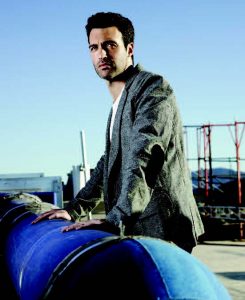
Photo by Alba Tull
EDGE: What was your major there?
RS: I ended up making my own major at Syracuse. I was in the Film department but I didn’t have a whole lot of access to actors because of the way the campus is set up. Syracuse Stage is a very reputable regional theater. The Theater department is located downtown, where that stage is. I was making my crappy little films and my teacher suggested that if I really wanted to know what it is I was asking of my actors, I should do it myself. So I started taking acting classes and learned their weird little language—what actors do and how to communicate with them. Which was amazing. I did a couple of black-box plays, things like that. I was terrible, but I loved the thrill of the live audience. I don’t know that I ever turned off my director’s brain, and I’m sure I drove my directors crazy. But in the end, I graduated with a degree in Directing, which wasn’t offered to undergrads at that time. Now it is, and I’m proud to have been the first.
EDGE: Usually in a TV series, a character has a particular trajectory. But in Veep, Dan is up, down, sideways, all over the place. Is there a challenge in inhabiting a character like that, or do you just sit back and see what the writers come up with next?
RS: It’s a little bit of both. Like, in Season Two, the writers said, “Dan’s going to be really bored.” I thought, crap, I don’t know how to do “really bored.” But slowly it came to light that he’s gunning for a position and eventually he became campaign manager. So they give you little hints as to what’s going to happen. The writers are truly inclusive about sharing information with us. From the beginning, Dan Egan was a guy—and he still is—a guy who to some degree is always shooting for the top. But they discovered it was much funnier for him to have him almost reach that top rung and then fall… [Laughs] almost as many times as I have!
EDGE: Dan is most entertaining when he has a foil, and you’ve had some good ones on Veep. Which character brings out the best in you and the worst in Dan?
RS: I’ve been lucky—in that Dan’s been lucky—to have great adversarial characters. Obviously, Jonah Ryan is the best. I love playing opposite Tim Simons so much. Not only are we good friends, but we slip in and out of those characters so easily now that we waste no time pussy-footing around it. We just get right into it. It’s such fun.
EDGE: How much of what we see on-screen is scripted versus improvisation?
RS: Honestly? It’s kind of right down the middle. The writers write very well thought-out, tight scripts. But because we’ve been inhabiting these people so long, they really trust us and encourage us to fill in the blanks. We have a long rehearsal process so we may have weeks with the script before we get in front of the camera. During that time, the writers may go back and re-write the scripts to incorporate our improvs. But by the time we get there, there’s a really wonderful framework. When we’re shooting, we’re shooting it as written, but we’ve had a hand in that. Then, of course, the day we are shooting, they say, “Take the leash off and do what you guys do.”
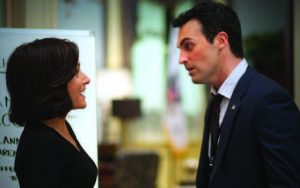
Courtesy of HBO
That’s what makes the show seem so natural, when we use the script as a roadmap and they choose the best takes in editing.
EDGE: The key to your character, I think, is that he is both relentless and just relentlessly self-absorbed.
RS: Oh, yeah. Dan is very into himself. He’s always got to climb. It’s always about him. Even when he’s serving someone else, he’ll serve them to the death…[Laughs] but that’s because it’s the other person’s death, not his.
EDGE: You’ve been a member of ensemble casts before. What makes this one work so well?
RS: We have a very large cast, which is unusual in and of itself. The fact that everyone gets along, even on a social level, that’s pretty amazing in Hollywood. We all really do. We’ve gone on vacations together! On this show the “family” has become a real family. Also, it’s unique that we all share the same sensibility. We just run with each other now, like a well-oiled machine. We’ll give each other little signals when we’re improv-ing. We know how to “dance” with each other.
EDGE: How does that happen?
RS: It feels like lightning striking. I’ve really got to credit our show runners and writers. They did an amazing job in casting. I don’t mean to sound self-serving but they found people who really worked well together. A lot of people don’t care about that—they just want the star, the famous name or face or whatever. But here they got actors who could really do this job, including the guest stars. It’s always great to see them parachute in for an episode or two and say, “What’s happening here? You guys are, like, speaking your own language.” And we wouldn’t want to work any other way.
EDGE: And yet, on camera, all the characters are slitting each other’s throats.
RS: Oh, totally. Everyone is out for themselves. They’re horrible and reprehensible.
EDGE: Your previous series, My Boys on TBS, had a pretty impressive cast, including Jim Gaffigan. Did you have a good comfort level with those actors over its four-season run?
RS: Yes, in fact that was the first thing that happened. During the tests for that show, we kind of sniffed each other out immediately. There were a dozen or so actors in there, all really wanting this job with this great, fun script. You could look around the room and almost tell who was going to make the cut. We instantly all gelled and bonded, and that’s because Betsy Thomas, the show’s creator, was like, “Get over to my house—we’ll play poker and get drunk together.”
EDGE: There seemed to be a fair amount of improvisation on that show, too.
RS: We did do a lot of improvisation on that show, which didn’t get talked about a lot. And that was really my first foray into improv. They’d do long takes and just let us go and go and go. It was wonderful, but I was terrified. I had taken some classes so I was familiar with how to improvise—I sort of wanted it in my quiver—but I hadn’t done it professionally. When I got around Mike Bunin, Jim Gaffigan and Jamie Kaler, who are incredible improvisers, it was an education. I learned on the job. At first, I was very uncomfortable, but by the end of Season Four I was, like, “Man this is what’s fun, this is real performance for me, letting go and having it come from yourself.” So that was the training that set me up to hang in with people like Julia Louis-Dreyfuss (above, left) and Matt Walsh. They were idols to me. It if weren’t for all that time on My Boys, I don’t think I would have been as comfortable on Veep.
EDGE: Julia Louis-Dreyfus and Jim Gaffigan (right, center) are old pros when it comes to performing in front of live audiences. What do you think they brought over to their roles on the filmed shows?
RS: Jim’s strength is that, right in the moment, he knows what’s funny. You always want to follow his lead. If he had a suggestion to make something funnier, maybe not so on-the-nose, we took it, and it was great. Julia is the same way but, like, on a gallon of steroids. She works so hard. I’ve never seen anybody who constantly works to make everything and everybody around her better—whether it’s tearing the script up and starting from scratch or finding those little funny moments. Julia has a tremendous work ethic and she’s also incredibly funny. It just comes naturally to her. Jim is more of a craftsman. He knows how to bury a joke in there, then tease it out in just the right way and deliver it. That’s what he does as a stand-up. Julia works the scene, she works the whole script. So on My Boys and Veep, I’ve basically had two masters courses in comedy.
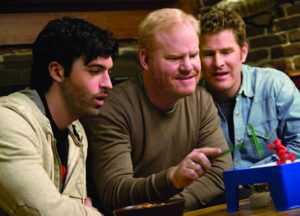
Sony Pictures Television/TBS
EDGE: You also played Dr. Todd on The Big C opposite Laura Linney. There was nothing comedic about that role.
RS: No, that was just the opposite. But again, I was very lucky. Laura is a lot like Julia, only on the dramatic side. She’s a workaholic. She breaks down every single moment, doesn’t rush things, plays things small. It’s amazing how comfortable she is. I learned so much from her. Laura is always willing to try something new, something different. On top of that, she is such a professional.
EDGE: In what ways?
RS: I mean, she knew everyone’s lines. Perfectly. There was a scene in Dr. Todd’s office where she’s crying because the cancer is progressing. She nailed it every single take, brought that raw emotion every single time. Meanwhile, I needed a couple of takes to get it right and I said, “I feel bad that I’ve been putting you through the wringer.” She said, “No. This is what we do.” For me it was like a lightbulb going off. You bring 100 percent every time—for your partner, for yourself, for the show.
Editor’s Note: The past few years, Reid Scott has made the most of his hiatus time from Veep. In addition to this year’s Home Again with Reese Witherspoon and Pico Alexander (above), he has co-starred with Kevin Kline in Dean and Jessica Alba in The Veil. He also played opposite Blythe Danner in I’ll See You In My Dreams.
Leading men come and go in Hollywood. Only a handful, though, have the ability to disappear into a supporting character. John Heard, who passed away shortly after this interview, was at home at either end of the spectrum, which accounts for his long, interesting career. Heard first wowed critics in his early 20s as an Obie-winning stage actor in New York, and quickly moved into film and television roles. He reeled off a string of memorable performances in the 1980s, including Cutter’s Way, Cat People, The Trip to Bountiful, Heaven Help Us, The Milagro Beanfield War, Big, Beaches, Mindwalk, Awakenings and The Pelican Brief. In 1990, he played Peter McCallister, the dad in Home Alone. Jenny Stewart knew John Heard for more than two decades. She reached out to John to get the story behind his role in Home Alone…and the unusual challenges he faced as one of the most recognized actors of his time
EDGE: When you got the script for Home Alone, did you have any idea that this was going to become such an iconic movie
JH: No. No idea
EDGE: Many people have pointed out that the premise is hard to swallow. Could a family board a plane for Europe and leave a child behind?
JH: That’s a good question. And that’s what Katherine O’Hara (above) and I had to ask ourselves. The two of us didn’t know. Between the two of us, she had the more difficult part. I could just be sort of a dummy, a goofy guy—I made him a gynecologist—I didn’t care, as long as she was as focused as she was in terms of losing our son. Then we learned that it was a comedy. Why is this funny? How do we play this? We didn’t really know how comedic all that slapstick stuff was going to be until we saw it. It wasn’t until the second Home Alone that we knew that we could be funny.
EDGE: So you both were playing it straight?
JH: We were playing it straight. Or, we were given an opportunity by the director to be comedic—but not necessarily personally comedic or funny, not somebody making jokes
EDGE: Have you ever misplaced a child and felt that kind of panic and terror
JH: Sure. From the moment you have children you’re experiencing that. I can remember a time when I was in a little video store, a perfectly safe place, in Rhinebeck, New York. My son, Jack, was four or five. I was talking to the girl who ran the store with her mother, and I turned around and he wasn’t there. We were towards the back of the store, so there wasn’t any place for him to go. It was literally like he had disappeared. I flipped out. I’d taught him not to run around to try to find a parent if he became separated, to stand in the same place where he lost his parent—teaching him his phone numbers, stuff like that. I started racing around in a circle. “Jack! Jack!!” Somehow he had managed to blend in with the videotapes in the corner of the store; I didn’t see him. I hugged him. “Oh, my God, there you are!” God, it was so horrible. I know the feeling, and it’s a really horrible feeling
EDGE: What do you remember from the set of Home Alone?
JH: Michael Jackson came to the set to see Macaulay Culkin. They were buddies. We were all getting into a van while we were shooting the ride to the airport, and I hit my head getting into the van. Someone took a picture of them standing in front of the van with me wearing the camel hair coat from the movie holding a hot water bottle on my head. I don’t know what happened to it
EDGE: You grew up in the Washington D.C. area. Do you consider that home
JH: That and New York City, I guess. I’ve spent an equal amount of time in each.
EDGE: What did your parents do?
JH: My father worked in the Pentagon. He was under assistant to the assistant to the under assistant to the Secretary of Defense. He was in charge of contracting and military appropriations. He was an engineer. On weekends, my father would go play his saxophone, which he loved dearly, and my mother would go and perform in a community theater play.
EDGE: Who got you into the theater as a young man?
JH: My mother, probably, and my sister, Cordis, who wanted to build a theater in our garage. My mother said to me, ”Why don’t you get out of the house and do something?” It was more of a threat that, if I didn’t, she would make life more difficult. The first show that I ever was in at the Chevy Chase Community Center was a show called The Happy Wanderer. The kid that was going to sing in the show got sick. He had one of those operatic voices at age 12. The lady that ran the group of us—she was very sweet, I had a crush on her—said to me, “All you have to do is walk around, John, and pretend like you’re singing…and we’ll play something.”
EDGE: Poor singing voice?
JH: Terrible. When I was in college, I did an operetta, and I only had one line to sing. I had a director who literally pulled his hair out every time I sang. And, he didn’t have much to pull out! He was like, “Don’t you hear yourself?”
EDGE: How many roles have you had where you had to sing?
JH: None. Well, actually, I did a repeat role in The Sopranos and they called me up and said, “Tony’s going to have a dream return thing, like years later, and you have to sing around the table. It’s part of the dream that he’s having, and you‘re singing [sings] You’re once…twice…three times a lady. That’s one of the hardest songs in the world for anybody to sing! So I called up David Chase, and said, “I’m not singing this. I can’t sing that song.” He said, “I never thought of that. It never occurred to me that you couldn’t sing.” Like it was all my fault. He didn’t change it, so I had to sing it. I had to take singing lessons for a week to sing even a note of it. And I had to sing it in front of Annette Bening and Jimmy Gandolfini, they were two people at the table. Annette was really nice. Gandolfini was always really funny. He said, “Wow, you sound a lot better off camera.” Annette Bening said, “Jimmy! Don’t be mean!” She was, like, give him a break. I never forgot how she stood up for me.
EDGE: One of your first movie roles was playing Jack Kerouac in the 1980 film Heart Beat along with Nick Nolte and Sissy Spacek. What was it like stepping into such an iconic character
JH: It was scary because I’m not anything like him. I picked a certain time when Jack Kerouac had written Maggie Cassidy about his hometown in Lowell, Mass. I identified with that. I went to school at Clark University, which was in Worcester, and I knew from counties and dark New England nights and so on and so forth. Also, he was a member of a boy’s gang, he was Catholic, he was Canadian—French Quebecois. He had a rugged side. He was poor, his mother looked out for him, I don’t remember if his father was around. But, he was a lot tougher than me. I was a little bit more effete, so I was worried that I was going to come off too bookish. Jack Kerouac seemed pretty downtrodden to me and he was such a heavy drinker. So I’d get into fights with the director, John Byrum, all the time. He’d say, “I don’t give a crap if it’s the real thing, just play the scene, stop being so glum.”
EDGE: He was looking for a different Kerouac.
JH: This was a time in Kerouac’s life when Carolyn Cassidy and Neal Cassidy and he, I think, were having the most fun—riding around, both of them being in love with her, and her with them. They were being cutting edge, so that was what the movie was trying to show. He didn’t want me to be Jack Kerouac in The Dark of Night. He used to take my girlfriend at the time, and put her on a ladder behind the camera, and surprise me so that she would make faces or something, shake her booty, so that I would perk up.
EDGE: What was it like off-set with Nick and Sissy?
JH: Sissy we didn’t see that much of; we scared her off very early on. She was like, “They’re going to throw me in the pool.” Nick and I—and his friend Billy Cross—hung out every night and just drove L.A. We were up all night every night, and went from one end of L.A. to the other. Billy drove. We’d pull into one house after another, 20 minutes apart, to see girls with their hair up in rollers, with their pajamas on, going [falsetto] ‘Hi, Nick!” with their face in their hands. Everybody loved Nick. I mean everybody loved Nick. Everywhere you went everyone loved Nick Nolte. He was great! He’s a great guy!
EDGE: He’s a man’s man.
JH: Yes. He’s very much a man’s man. All the stunt guys used to love him. We used to drink over at The River Bottom, and they would actually come in the back room and sit down in our booth to meet Nick and say hi to Nick. That’s a very rare thing for an actor; that was quite a tribute. With me, it was like “Who’s he?”
EDGE: How did coming of age in the late 1960’s influence who you are?
JH: After college, I went to [grad school at] Catholic University to stay out of Vietnam. It was a stupid decision, since they weren’t giving anybody deferments for going to grad school anymore. But, I tried anyway! I thought that I’d get a master’s degree in theater drama. I’ll teach…that will be fun…I’ll be connected to the theater, get hooked up in some theater department somewhere in the United States and stay in that privileged world of academics. It was 1968, and I was graduated from college and I didn’t know what to do. It was a time when everything was interconnected with an alternate lifestyle.
EDGE: And?
JH: I realized that I had no ability whatsoever to write a masters thesis! But, Catholic U. had a touring theater company that traveled around the country performing plays for $80 a week. My acting teacher said I could go. His actual words were, “Everyone else is in Vietnam, John, so yeah, you can go.” I guess you can say that’s when the “acting bug” hit. We drove everywhere—Iowa, Michigan, Georgia. Setting up the show, performing, breaking it down. And, in between, we were getting into all sorts of trouble. It was a political time. It was a lifestyle. It was anti-government, anti-corporations. It was a great way of being in touch with everything that was going on in your lifetime at that age.
EDGE: Did you consider yourself a hippie?
JH: I didn’t have the guts to go the whole distance as a hippie. Friends of mine did. You have to remember that we were all supposed to go to Vietnam because of the draft. Extreme things had to be done to stay out of going. Some guys tried to flunk the physical, or said they were crazy. I didn’t have to do any of that because of theater, I was lucky enough to work.
EDGE: What should I add to my Netflix queue to see John Heard at his best?
JH: Everybody points to Cutter’s Way (above). I don’t know. That was another instance of me being not quite gritty enough. That’s what Billy, Nick’s friend, said. Maybe Big. Although Big is a little one-note. I wish I had done more in Big. I was just trying to get through the words and make them believable. Sometimes, you have to show up and remember to be creative, to come with something that’s not straightforward.
EDGE: You were a bad guy in Big. Do you prefer playing the bad guy or do you like the funny, good guy roles?
JH: I would prefer to play the “theater of the absurd” guy—an Ionesco kind of a transition from World War II into the ’60’s kind of thing. Not-stand up humor. A humorous character with a point of view, but not trying to be funny. Playing a bad guy for me, that’s hard.
EDGE: How so?
JH: Because there is a tendency for me to become over-emotional, and most bad guys are great when they are emotionless. They’re straightforward, prepossessed and physically formidable. Look at Joe Pesci. He’s only—what?—five feet tall. But every time Joe gets pissed he’s so wonderfully bad ass. And yet, at the same time, he’s the funniest guy in the world! You know when he did that thing about “What’s so funny about me?” in Goodfellas, well he did that to me one night in a hotel. He came in and I was standing at the front desk. He told me a story about some guy that kept bugging him. He kept saying [spot-on Joe Pesci imitation] “Don’t make me come ova dere, don’t make me come ova dere.” I think he was trying it out on me, because he ended up putting that in Home Alone, and it was hilarious. He has some kind of unique combination of talent, a voice and a physicality that he blends into one person. He’s engaging as a bad guy and that’s where I’d like to be.
EDGE: Are you still having fun acting?
JH: Yes. I have a lot of fun. I like to have fun. I like to screw around and I like to be sort of a jerk, and give people a hard time, get people to leave me alone. They think that I’m some big grouch. But people forget that you’re standing there between takes and you’re thinking about what you’re going to do or what you’re going to say.
EDGE: Are you interested in doing stage again?
JH: Yes, I love the stage. I love theater, its’ my first choice. I always think that I could be great on stage. I don’t know why. I think that’s the tradition of being on stage, you think you can be great. I don’t think you think that as much in movies. But, I think that about theater.
EDGE: Is that because of the energy you get from the audience?
JH: Maybe. I just think traditionally every young actor thinks my Hamlet is going to be the greatest Hamlet!
Editor’s Note: John Heard passed away following back surgery on July 21 in Palo Alto. After turning off her recorder, Jenny Stewart asked John what his future plans were. His final words to her were, “Let the chips fall where they may.” Jenny had this to add: “Ironically, our interview started with us joking around about his inclusion in a celebrity death hoax scam that had gone viral. He humbly thought that he was being confused with the actor John Hurt, who had died in January. I offered that he, John Heard, was now part of an elite crowd of performers whose deaths were faked on social media. John was a contradiction of terms. He came from the Washington D.C. establishment, yet spoke—and sometimes acted—like a character from Easy Rider. He was gritty, yet mannered, dangerously funny yet hermetic in times of self-doubt. He initially wanted to take a safer path in life, but ended up on Mr. Toad’s Wild Ride, which brought him celebrity and, I hope, happiness.”
How soon after George Bush named Iran as a member of the “Axis of Evil” did you realize what a gift that was?
I got upset at first! As an Iranian in America, I’ve been here now for almost 40 years. The moment I came, Iran was on the list of public enemies and it has remained there. Really, it’s pretty frustrating. Yet at the same time, it is a gift because comedy is about emotion and passion, as well as having a point of view. We watch a guy like Lewis Black lose his mind and it makes us laugh. I think when I got upset about it, it helped me then to be able to talk about it in a passionate way.
How important is it to take audiences out of their comfort zone?
I think it’s important to push a little bit, to make people be open-minded a little more, to open up their boundaries. I’ll cuss here and there, but my shows are not X-rated. I feel like somewhere in the back of my mind I’ve got my mother or father’s voice in my head criticizing me if I’m saying anything that’s even a little risqué. That said, when I do a headlining show, there’s obviously a lot of Middle Easterners in the audience, so when I make some type of [sexual] innuendo, I’ll make fun of the fact I know what my audience is thinking. It’s become a part of my act. I enjoy calling them out on it because I think, when you do that, it helps them come on the ride with you.
Maya Angelou said Don’t trust anyone who doesn’t laugh. Do you agree?
I do. And I feel sorry for anyone who doesn’t laugh. I’ll do a show for a cultural event that’s been sponsored by, let’s say, a Persian group, and so there are kids there and the elderly, and my material sometimes is a little edgy for them. Recently, a woman came up to me afterwards and said, “I just want you to know that people might not have been laughing because they were a little older and maybe they were just offended by some of the stuff you said.” I told her, “I appreciate you telling me that but I honestly feel that, if they’re offended by my stuff, I think they have bigger issues…and should talk those issues through with a therapist.”
When did you realize you had the ability to make people laugh?
Coming to America in the late-70’s when I was six years old, I remember there were three things that helped me adapt to the new country. One was sports—I was good at kickball and soccer. Another was that I would go grocery shopping with my mom and just buy a ton of sweets, and quite often I would take extra sweets to school and hand them out to my newfound friends. I was bribing my way into their hearts with Starburst. The third way, definitely, was being funny. I like laughing and I like making people laugh. And I stuck with it.
How did you develop your comic timing?
It probably started first as an actor. When I was 12 years old in school, we did musicals and I loved being on stage; as soon as I stepped on stage I felt alive. I was a huge fan of Eddie Murphy—to this day he is my comic hero. I wanted to be a comedian, but I just didn’t have the confidence then, so the actor part came first and the comedian part came second. EDGE










